Mineralogy and Origin of Vein Wolframite Mineralization from the Pohled Quarry, Havlíčkův Brod Ore District, Czech Republic: Interaction of Magmatic and Basinal Fluids
Abstract
1. Introduction
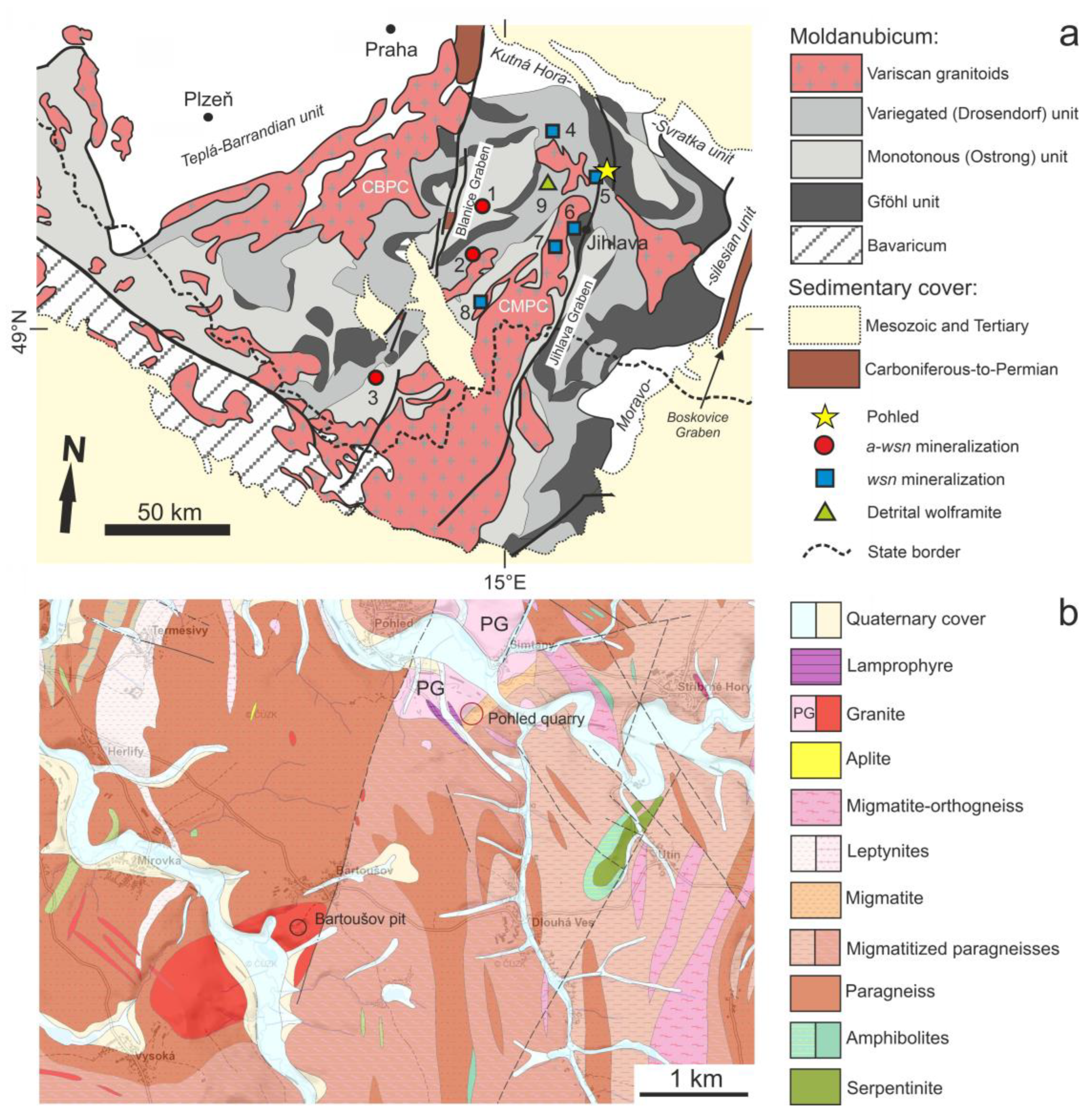
2. Background
2.1. Geological Setting
2.2. Wolframite Mineralization in the Moldanubicum
3. Material and Methods
4. Results
4.1. Mineralogy
4.1.1. Ore Minerals
4.1.2. Gangue and Other Accessory Minerals
4.2. Fluid Inclusions
4.3. Stable Isotopes
5. Discussion
5.1. Paragenetic Evolution of the Mineral Assemblage
5.2. Fluid Composition and Trapping Mode
5.3. Formation Conditions
- Primary and pseudosecondary aqueous fluid inclusions hosted by the studied vein minerals yielded highly variable homogenization temperatures across the vein paragenesis, ranging from ca. 370 °C (scheelite) to less than 100 °C (late L-only fluid inclusions hosted by quartz and calcite). Because fluid inclusions appear to be trapped from a homogeneous fluid in all cases, they represent the minimum possible trapping temperatures. The true formation of P–T conditions can be located somewhere on appropriate isochores using independent temperature and/or pressure estimates [52]. However, it is impossible to prove the contemporaneous timing of certain observed fluid episodes and independent temperature estimates derived from another mineral phases (see below). Therefore, the determination of pressure conditions remains uncertain (Figure 26).
- 2.
- The application of a quartz–scheelite oxygen isotope thermometer by [79] to the measured δ18O values yielded a temperature estimate of 132 °C, which is clearly strongly underestimated, when compared with the homogenization temperatures of primary and pseudosecondary fluid inclusions showing Th values mostly above 200 °C in both minerals. This indicates that quartz and scheelite have crystallized out of isotope equilibrium, presumably during different periods and from different fluids. This interpretation is consistent with the different Th values and, partly, also the salinities of the fluid inclusions in both minerals.
- 3.
- The cationic (Fe–Co–Ni) composition of sulfoarsenides yields, for many obtained WDS analyses, high temperature estimates exceeding 550 °C (Figure 13a). These temperatures are significantly higher than those suggested from other thermometers and mineral phases. In addition, the missing positive correlation between As and Co (Figure 13b), which is commonly reported for natural sulfoarsenides [63,80,81], is unusual, and probably indicates a chemical disequilibrium. The latter is also clearly suggested from the sector zoning of some grains (cf. [82]). In this case, we suggest that the entrance of cations into the structure of crystallizing sulfoarsenides was likely not primarily driven by the temperature, but by the actual availability of individual elements. Another approach involves thermometry based on the contents of As in arsenopyrite [80,83]. For these thermometric purposes, [81] does not recommend the use of arsenopyrite containing as little as 0.2 wt. % Co. Excluding these Co-enriched compositions, the measured As contents between 28.1 and 32.5 at. % suggest (though there is a high uncertainty in estimation of sulfur fugacity from mineral assemblage) a more reasonable range of crystallization temperatures between ca. 430 and <200 °C (Figure 26).
- 4.
- The elevated contents of Th in uraninite are consistent with a high-temperature origin of this mineral phase [84].
- 5.
- 6.
- 7.
- 8.
- The upper limit of the temperature stability of monoclinic pyrrhotite lies between 225 and 315 °C, according to both experimental data and natural evidence [89].
- 9.
- A stable negative Eu anomaly in xenotime (Figure 10c) indicates that the temperature was above ca. 200 °C, because divalent Eu is stable at high temperatures [90] and Eu2+ has a larger ion size with respect to neighboring trivalent REEs, preventing its incorporation into crystallizing REE minerals. In contrast, a variability of temperature around the critical value of ca. 200 °C, associated with the thermochemical oxidation/reduction of Eu2+ to Eu3+ and vice versa [90], can be the reason for the highly variable Eu/Eu* values in late unknown Ca-Y-REE silicate (Figure 10d).
- 10.
5.4. Origin of Fluids and Mineral-Forming Components
5.5. Genetic Model
5.6. Regional Metallogenetic Implications
6. Conclusions
Supplementary Materials
Author Contributions
Funding
Data Availability Statement
Acknowledgments
Conflicts of Interest
References
- Franke, W. The mid-European segment of the Variscides: Tectonostratigraphic units, terrane boundaries and plate tectonic evolution. In Orogenic Processes: Quantification and Modelling in the Variscan Belt; Franke, W., Haack, V., Oncken, O., Tanner, D., Eds.; Geological Society, Special Publications: London, UK, 2000; Volume 179, pp. 35–61. [Google Scholar]
- Neßler, J.; Seifert, T.; Gutzmer, J.; Müller, A. Contribution to the exploration and metallogenic characteristic of the Li-Sn-W-greisen deposit Zinnwald, eastern Erzgebirge, Germany. Freiberg. Forschungsheft. C 2017, 552, 1–390. (In German) [Google Scholar]
- Hreus, S.; Výravský, J.; Cempírek, J.; Breiter, K.; Galiová, M.; Krátký, O.; Šešulka, V.; Škoda, R. Scandium distribution in the world-class Li-Sn-W Cínovec greisen-type deposit: Result of a complex magmatic to hydrothermal evolution, implications for scandium valorization. Ore Geol. Rev. 2021, 139, 104433. [Google Scholar] [CrossRef]
- Thomas, R. Fluid evolution in relation to the emplacement of the Variscan granites in the Erzgebirge region: A review of the melt and fluid inclusion evidence. In Metallogeny of Collisional Orogens; Seltmann, R., Kämpf, H., Möller, P., Eds.; Czech Geological Survey: Prague, Czech Republic, 1994; pp. 150–158. [Google Scholar]
- Dolejš, D.; Štemprok, M. Magmatic and hydrothermal evolution of Li-F granites: Cínovec and Krásno intrusions, Krušné hory batholith, Czech Republic. Bull. Czech Geol. Surv. 2001, 76, 77–99. [Google Scholar]
- Štemprok, M.; Pivec, E.; Langrová, A. The petrogenesis of a wolframite-bearing greisen in the Vykmanov granite stock, Western Krušné hory pluton (Czech Republic). Bull. Geosci. 2005, 80, 163–184. [Google Scholar]
- Dolníček, Z.; René, M.; Prochaska, W.; Kovář, M. Fluid evolution of the Hub Stock, Horní Slavkov-Krásno Sn-W ore district, Bohemian Massif, Czech Republic. Miner. Depos. 2012, 47, 821–833. [Google Scholar] [CrossRef]
- Breiter, K.; Ďurišová, J.; Hrstka, T.; Korbelová, Z.; Hložková Vaňková, M.; Vašinová Galiová, M.; Kanický, V.; Rambousek, P.; Knésl, I.; Dobeš, P.; et al. Assessment of magmatic vs. metasomatic processes in rare-metal granites: A case study of the Cínovec-Zinnwald Sn–W–Li deposit, central Europe. Lithos 2017, 292, 198–217. [Google Scholar] [CrossRef]
- Krejčí Kotlánová, M.; Dolníček, Z.; René, M.; Prochaska, W.; Ulmanová, J.; Kapusta, J.; Mašek, V.; Kropáč, K. Fluid evolution of greisens from Krupka Sn-W ore district, Bohemian Massif (Czech Republic). Minerals 2024, 14, 86. [Google Scholar] [CrossRef]
- Pauliš, P.; Kopecký, S.; Dolníček, Z.; Sejkora, J.; Pour, O.; Ulmanová, J.; Kopecký, S., Jr. Wolframová a sulfidická hydrotermální mineralizace z Pekelského vrchu u Jihlavy (Česká republika). Bull. Mineral. Petrol. 2022, 30, 73–94. (In Czech) [Google Scholar] [CrossRef]
- Ferenc, Š.; Uher, P. Magnesian wolframite from hydrothermal quartz veins in the Rochovce granite exocontact, Ochtiná, Western Carpathians, Slovakia. Neues Jahrb. Mineral. Abh. 2007, 183, 165–172. [Google Scholar] [CrossRef]
- Miyawaki, R.; Yokoyama, K.; Matsubar, S. Huanzalaite, MgWO4, a new mineral species from the Huanzala Mine, Peru. Can. Mineral. 2010, 48, 105–112. [Google Scholar] [CrossRef]
- Losertová, L.; Houzar, S.; Buřival, Z.; Losos, Z. Wolframit ve šlichových vzorcích lokality Trucbába—Valcha, moldanubikum. Acta Mus. Morav. Sci. Geol. 2012, 97, 77–84. (In Czech) [Google Scholar]
- Losertová, L.; Buřival, Z.; Losos, Z.; Houzar, S. Minerální asociace a chemické složení Mg-wolframitu a scheelitu z Cetoraze u Pacova, Česká republika. Acta Mus. Moravie Sci. Geol. 2013, 98, 41–48. (In Czech) [Google Scholar]
- Losertová, L.; Buřival, Z.; Losos, Z. Minerální asociace Sn-W zrudnění z Ovesné Lhoty u Světlé nad Sázavou, Česká republika. Acta Mus. Morav. Sci. Geol. 2014, 99, 69–76. (In Czech) [Google Scholar]
- Bernard, J.H. Minerals of ore-bearing hydrothermal processes—The Bohemian Massif. In Mineralogy of Czechoslovakia; Bernard, J.H., Čech, F., Dávidová, Š., Dudek, A., Fediuk, F., Hovorka, D., Kettner, R., Koděra, M., Kopecký, L., Němec, D., et al., Eds.; Academia: Prague, Czech Republic, 1981; pp. 186–343. (In Czech) [Google Scholar]
- Němec, D.; Tenčík, I. Regionally metamorphosed greisens at Cetoraz, The Bohemian-Moravian heights (Českomoravská vrchovina), Czechoslovakia. Mineral. Depos. 1976, 11, 210–217. [Google Scholar] [CrossRef]
- Němec, D.; Páša, J. Regionally metamorphosed greisens of the Moldanubicum. Mineral. Depos. 1986, 21, 12–21. [Google Scholar] [CrossRef]
- Kadlec, T. Nové mineralogické nálezy z kamenolomu Pohled u Havlíčkova Brodu I. Minerál submitted. (In Czech)
- Geological Map of the Czech Republic 1:50000. Available online: https://mapy.geology.cz/geocr50/ (accessed on 3 February 2023).
- Breiter, K.; Gnojek, I.; Chlupáčová, M. Radioactivity patterns—Constraints for the magmatic evolution of the two-mica granites in the Central Moldanubian pluton. Věst. Čes. Geol. Úst. 1998, 73, 301–311. [Google Scholar]
- Žák, J.; Verner, K.; Finger, F.; Faryad, S.W.; Chlupáčová, M.; Veselovský, F. The generation of voluminous S-granite in the Moldanubian unit, Bohemian Massif, by rapid isothermal exhumation of the metapelitic middle crust. Lithos 2011, 121, 25–40. [Google Scholar] [CrossRef]
- McCann, T. The Geology of Central Europe: Precambrian and Palaeozoic; Geological Society: London, UK, 2008. [Google Scholar]
- Pešek, J.; Holub, V.; Jaroš, J.; Malý, L.; Martínek, K.; Prouza, V.; Spudil, J.; Tásler, R. Geology and Deposits of the Upper Paleozoic Limnic Basins of the Czech Republic; Czech Geological Survey: Prague, Czech Republic, 2001; 243p. (In Czech) [Google Scholar]
- Suchý, V.; Zachariáš, J.; Sýkorová, I.; Kořínková, D.; Pešek, J.; Pachnerová Brabcová, K.; Luo, Q.; Filip, J.; Světlík, I. Palaeo-thermal history of the Blanice Graben (the Bohemian Massif, Czech Republic): The origin of anthracite in a late-Variscan strike-slip basin. Int. J. Coal Geol. 2022, 263, 104129. [Google Scholar] [CrossRef]
- Koutek, J. Occurrence of unmetamorphosed conglomerates in gneissic area near Německý Brod. Věst. Stát. Geol. Úst. 1940, 53–56. (In Czech) [Google Scholar]
- Doleželová, T. Hydrotermální Alterace Vybraných Typů Hornin v Havlíčkobrodském Rudním Revíru (Moldanubikum). Master’s Thesis, Palacký University, Olomouc, Czech Republic, 2015. (In Czech). [Google Scholar]
- René, M.; Dolníček, Z. Granitoids of the Mauthausen type in the Czech part of the Moldanubian Batholith. In Recent Advances in Mineralogy; René, M., Ed.; InTech Open: London, UK, 2023; pp. 11–29. [Google Scholar]
- Dolníček, Z.; Malý, K.; Ulmanová, J.; Havlíček, J.; Vrtiška, L. Minerály kontaminovaných granitových pegmatitů z lomu Pohled u Havlíčkova Brodu (moldanubikum), část I: Oxidy, karbonáty, silikáty a fosfáty. Bull. Mineral. Petrol. 2020, 28, 132–151. (In Czech) [Google Scholar] [CrossRef]
- Dolníček, Z.; Ulmanová, J.; Malý, K.; Havlíček, J.; Sejkora, J. Minerály kontaminovaných granitových pegmatitů z lomu Pohled u Havlíčkova Brodu (moldanubikum), část II: Prvky a sulfidy. Bull. Mineral. Petrol. 2021, 29, 90–107. (In Czech) [Google Scholar] [CrossRef]
- Houzar, S.; Hrazdil, V.; Hršelová, P.; Toman, J.; Buřivalová, L.; Grossmannová, D.; Hladišová, T.; Litochleb, J.; Malý, K.; Škrdla, P.; et al. Historické Dolování Drahých Kovů na Českomoravské Vrchovině; Moravské Zemské Muzeum Brno: Brno, Czech Republic, 2021; 476p. (In Czech) [Google Scholar]
- Hak, J.; Johan, Z. Mineralogicko-geochemický výzkum indiové anomálie Pohled u Havlíčkova Brodu. Sborn. Geol. Věd Technol. Geochem. 1961, 2, 77–101. (In Czech) [Google Scholar]
- Dobeš, P.; Malý, K. Mineralogie polymetalických rudních výskytů ve střední části havlíčkobrodského revíru. Vlast. Sborn. Vysoč. Odd. Přír. Věd. 2001, 15, 51–85. (In Czech) [Google Scholar]
- Malý, K.; Dolníček, Z. Pb–Zn–Ag vein mineralization of the central part of the Českomoravská vrchovina Upland (Czech Republic): S, C, and O stable isotope study. Bull. Geosci. 2005, 80, 307–319. [Google Scholar]
- Mastíková, E. Geologická Dokumentace Lomu Pohled (Moldanubikum). Bachelor’s Thesis, Palacký University, Olomouc, Czech Republic, 2009. (In Czech). [Google Scholar]
- Mastíková, E. Mineralogie a Podmínky Vzniku Vybraných Mineralizací v Lomu Pohled (Moldanubikum). Master’s Thesis, Palacký University, Olomouc, Czech Republic, 2011. (In Czech). [Google Scholar]
- Pauliš, P.; Kopecký, S.; Jebavá, I.; Havlíček, J. Nové mineralogické nálezy z kamenolomu Pohled u Havlíčkova Brodu. Minerál 2013, 21, 317–322. (In Czech) [Google Scholar]
- Havlíček, J.; Výravský, J.; Malý, K. Nálezy zeolitů v lomu Pohled u Havlíčkova Brodu. Acta Rer. Nat. 2018, 22, 1–3. (In Czech) [Google Scholar]
- Kadlec, T. Nález scheelitového zrudnění v kamenolomu Pohled u Havlíčkova Brodu. Minerál 2018, 24, 502–508. (In Czech) [Google Scholar]
- Dolníček, Z.; Ulmanová, J.; Malý, K.; Havlíček, J.; Krejčí Kotlánová, M.; Koutňák, R. Mineralogická charakteristika žilné křemenné mineralizace s molybdenitem z lomu Pohled, havlíčkobrodský rudní revír, Česká republika. Acta Mus. Morav. Sci. Geol. 2023, 108, 145–170. (In Czech) [Google Scholar]
- Moupic, Z.; Tošer, Z. Nález molybdenitového zrudnění na lokalitě Pohled u Havlíčkova Brodu. Čas. Mineral. Geol. 1985, 30, 331–332. (In Czech) [Google Scholar]
- Seidlová, V. Mineralogická charakteristika molybdenitového výskytu z lomu Pohled u Havlíčkova Brodu. Bachelor’s Thesis, Masaryk University, Brno, Czech Republic, 2011. (In Czech). [Google Scholar]
- Novák, M. Granitické pegmatity Českého masívu (Česká republika); mineralogická, geochemická a regionální klasifikace a geologický význam. Acta Mus. Morav. Sci. Geol. 2005, 90, 3–75. (In Czech) [Google Scholar]
- Losertová, L. Přehled wolframitové mineralizace vázané na centrální moldanubický pluton a na ortorulová tělesa v moldanubiku. Acta Mus. Morav. Sci. Geol. 2015, 100, 45–67. (In Czech) [Google Scholar]
- Prchlík, I.; Jeřábek, M. Wolframové zrudnění u Cetoraze, západně od Pacova. Věst. Ústř. Úst. Geol. 1965, 40, 47–49. (In Czech) [Google Scholar]
- Pauliš, P.; Kopecký, S. Occurrence of tungsten mineralization at Vysoká near Havlíčkův Brod (Czech Republic). Acta Rer. Nat. 2007, 3, 47–50. (In Czech) [Google Scholar]
- Pouchou, J.L.; Pichoir, F. “PAP” (φρZ) procedure for improved quantitative microanalysis. In Microbeam Analysis; Armstrong, J.T., Ed.; San Francisco Press: San Francisco, CA, USA, 1985; pp. 104–106. [Google Scholar]
- Anders, E.; Grevesse, N. Abundances of the elements: Meteoritic and solar. Geochim. Cosmochim. Acta 1989, 53, 197–214. [Google Scholar] [CrossRef]
- McLennan, S.M. Rare earth elements in sedimentary rocks: Influence of provenance and sedimentary processes. Rev. Mineral. 1989, 21, 169–200. [Google Scholar]
- Monecke, T.; Kempe, U.; Monecke, J.; Sala, M.; Wolf, D. Tetrad effect in rare earth element distribution patterns: A method of quantification with application to rock and mineral samples from granite-related rare metal deposits. Geochim. Cosmochim. Acta 2002, 66, 1185–1196. [Google Scholar] [CrossRef]
- Burke, E.A.J. Raman microspectrometry of fluid inclusions. Lithos 2001, 55, 139–158. [Google Scholar] [CrossRef]
- Roedder, E. Fluid inclusions. Rev. Mineral. 1984, 12, 1–644. [Google Scholar]
- Shepherd, T.J.; Rankin, A.H.; Alderton, D.H.M. A Practical Guide to Fluid Inclusion Studies; Blackie and Glasgow: London, UK, 1985. [Google Scholar]
- Bodnar, R.J. Revised equation and table for determining the freezing point depression of H2O-NaCl solutions. Geochim. Cosmochim. Acta 1993, 57, 683–684. [Google Scholar] [CrossRef]
- Bakker, R.J. Package FLUIDS 1. Computer programs for analysis of fluid inclusion data and for modelling bulk fluid properties. Chem. Geol. 2003, 194, 3–23. [Google Scholar] [CrossRef]
- Zhang, Y.G.; Frantz, J.D. Determination of the homogenisation temperatures and densities of superficial fluids in the system NaCl-KCl-CaCl2-H2O using synthetic fluids inclusions. Chem. Geol. 1987, 64, 335–345. [Google Scholar] [CrossRef]
- Dixon, A.; Cempírek, J.; Groat, L.A. Mineralogy and geochemistry of pegmatites on Mount Begbie, British Columbia. Can. Mineral. 2014, 52, 129–164. [Google Scholar] [CrossRef]
- Dolníček, Z.; Ulmanová, J.; Havlíček, J.; Malý, K.; Jačková, I. Fluorite-bearing vein mineralization from Bartoušov near Havlíčkův Brod: A complex fluid history related to post-Variscan uplift of the Moldanubian basement (Bohemian Massif, Czech Republic). J. Geosci. 2023, 68, 261–279. [Google Scholar] [CrossRef]
- Pauliš, P.; Kopecký, S.; Dolníček, Z.; Sejkora, J. Hydrotermální sulfidická mineralizace ze Skalky v havlíčkobrodském rudním revíru (Česká republika). Acta Mus. Morav. Sci. Geol. 2024, 109, 3–35. (In Czech) [Google Scholar]
- Fojt, B.; Dolníček, Z.; Kopa, D.; Sulovský, P.; Škoda, R. Paragenetická charakteristika hypogenních minerálních asociací uranového ložiska Zálesí u Javorníku ve Slezsku. Acta Mus. Silesiae A 2005, 54, 223–280. (In Czech) [Google Scholar]
- Kaneda, H.; Takenouchi, S.; Shoji, T. Stability of pentlandite in the Fe-Ni-Co-S system. Miner. Depos. 1986, 21, 169–180. [Google Scholar] [CrossRef]
- Becker, M.; De Villiers, J.; Bradshaw, D. The mineralogy and crystallography of pyrrhotite from selected nickel and PGE ore deposits. Econ. Geol. 2010, 105, 1025–1037. [Google Scholar] [CrossRef]
- Klemm, D. Synthesen und Analysen in den Dreiecksdiagrammen FeAsS-CoAsS-NiAsS und FeS2-CoS2-NiS2. Neues Jahrbuch Mineral. Abh. 1965, 103, 205–255. (In German) [Google Scholar]
- Bossi, F.; Biagioni, C.; Pasero, M. Nomenclature and classification of the spinel supergroup. Eur. J. Mineral. 2018, 31, 183–192. [Google Scholar] [CrossRef]
- Škácha, P.; Sejkora, J.; Plášil, J.; Dolníček, Z.; Ulmanová, J. Grimmite, NiCo2S4, a new mineral of spinel supergroup from Příbram, Czech Republic. Eur. J. Mineral. 2021, 33, 175–187. [Google Scholar] [CrossRef]
- Rieder, M.; Cavazzini, G.; D’yakonov, Y.S.; Kamenetskii, V.A.F.; Gottardi, G.; Guggenheim, S.; Koval’, P.V.; Mueller, G.; Neiva, A.M.R.; Radoslovich, E.W.; et al. Nomenclature of the micas. Can. Mineral. 1998, 36, 905–912. [Google Scholar] [CrossRef]
- Maydagán, L.; Franchini, M.; Impiccini, A.; Lentz, D. Phyllosilicates geochemistry and distribution in the Altar porphyry Cu-(Au) deposit, Andes Cordillera of San Juan, Argentina: Applications in exploration, geothermometry, and geometallurgy. J. Geochem. Explor. 2016, 167, 83–109. [Google Scholar] [CrossRef]
- Wiewióra, A.; Weiss, Z. Crystallochemical classifications of phyllosilicates based on the unified system of projection of chemical composition: II. The chlorite group. Clay Miner. 1990, 25, 83–92. [Google Scholar] [CrossRef]
- Bayliss, P. Nomenclature of the trioctahedral chlorites. Can. Mineral. 1975, 13, 178–180. [Google Scholar]
- Melka, K. Návrh na klasifikaci chloritových minerálů. Věst. Ústř. Úst. Geol. 1965, 40, 23–27. (In Czech) [Google Scholar]
- Cathelineau, M. Cation site occupancy in chlorites and illites as a function of temperature. Clay Miner. 1988, 23, 471–485. [Google Scholar] [CrossRef]
- Stormer, J.C., Jr.; Pierson, M.J.; Tacker, R.C. Variation of F and Cl X-ray intensity due to anisotropic diffusion of apatite during electron microprobe analysis. Am. Mineral. 1993, 78, 641–648. [Google Scholar]
- Loun, J.; Čejka, J.; Sejkora, J.; Plášil, J.; Novák, M.; Frost, R.L.; Palmer, S.J.; Keeffe, E.C. A Raman spectroscopic study of bukovskýite Fe2(AsO4)(SO4)(OH)· 7H2O, a mineral phase with a significant role in arsenic migration. J. Raman Spectrosc. 2011, 42, 1596–1600. [Google Scholar] [CrossRef]
- Ulmanová, J. Conditions of Formation of Selected Hydrothermal Vein Deposits in Central Part of the Bohemian Massif. Master’s Thesis, Charles University, Prague, Czech Republic, 2018. (In Czech). [Google Scholar]
- Murowchick, J.B. Marcasite inversion and the petrographic determination of pyrite ancestry. Econ. Geol. 1992, 87, 1141–1152. [Google Scholar] [CrossRef]
- Qian, G.; Xia, F.; Brugger, J.; Jiafang, B.; Chen, G.; Pring, A. Replacement of pyrrhotite by pyrite and marcasite under hydrothermal conditions up to 220 °C: An experimental study of reaction textures and mechanisms. Am. Mineral. 2011, 96, 1878–1893. [Google Scholar] [CrossRef]
- Borisenko, A.S. Izučenije solevovo sostava rastvorov gazovo-židkich vključenij v mineralach metodom kriometrii. Akad. Nauk SSSR Sibir. Odd. 1977, 8, 16–27. (In Russian) [Google Scholar]
- Vityk, M.O.; Bodnar, R.J. Textural evolution of synthetic fluid inclusions in quartz during reequilibration, with applications to tectonic reconstruction. Contrib. Mineral. Petrol. 1995, 121, 309–323. [Google Scholar] [CrossRef]
- Zheng, Y.-F. Oxygen isotope fractionation in wolframite. Eur. J. Mineral. 1992, 4, 1331–1335. [Google Scholar] [CrossRef]
- Kretschmar, U.; Scott, S.D. Phase relations involving arsenopyrite in the system Fe-As-S and their application. Can. Mineral. 1976, 14, 364–386. [Google Scholar]
- Sundblad, K.; Zachrisson, E.; Smeds, S.-A.; Berglund, S.; Ålinder, C. Sphalerite geobarometry and arsenopyrite geothermometry applied to metamorphosed sulfide ores in the Swedish Caledonides. Econ. Geol. 1984, 79, 1660–1668. [Google Scholar] [CrossRef]
- Kerestedjian, T. Chemical and morphological features of arsenopyrite, concerning its use as a geothermometer. Mineral. Petrol. 1997, 60, 231–243. [Google Scholar] [CrossRef]
- Sharp, Z.D.; Essene, E.J.; Kelly, W.C. A re-examination of the arsenopyrite geothermometer: Pressure considerations and applications to natural assemblages. Can. Mineral. 1985, 23, 517–534. [Google Scholar]
- Alexandre, P.; Layton-Matthews, D.; Joy, B.; Uvarova, Y. Chemical compositions of natural uraninite. Can. Mineral. 2015, 53, 595–622. [Google Scholar] [CrossRef]
- Deer, W.A.; Howie, R.A.; Zussman, J. Rock-Forming Minerals, Vol. 4A: Feldspars; Geological Society: London, UK, 2001. [Google Scholar]
- Fleet, M.A. Rock-Forming Minerals, Vol. 3A, Micas; The Geological Society: London, UK, 2003. [Google Scholar]
- Kostov, I.; Stefanova, J.M. Sulphide minerals. In Crystal Chemistry, Parageneses and Systematics; Bulgarian Academy of Science: Sofia, Bulgaria, 1981; 212p. [Google Scholar]
- Čvileva, T.N.; Bezsmertnaja, M.S.; Spiridonov, E.M.; Agroskin, A.S.; Papayan, G.V.; Vinogradova, R.A.; Lebedeva, S.I.; Zavjalov, E.N.; Filimonova, A.A.; Petrov, V.K.; et al. Handbook for Determination of Ore Minerals in Reflected Light; Nedra: Moscow, Russia, 1988; 504p. (In Russian) [Google Scholar]
- Kontny, A.; De Wall, H.; Sharp, T.G.; Pósfai, M. Mineralogy and magnetic behavior of pyrrhotite from a 260 °C section at the KTB drilling site, Germany. Am. Mineral. 2000, 85, 1416–1427. [Google Scholar] [CrossRef]
- Sverjensky, D.A. Europium redox equilibria in aqueous solution. Earth Planet. Sci. Lett. 1984, 67, 70–78. [Google Scholar] [CrossRef]
- Aplomov, V.S.; Sereda, E.V. Formation temperatures of quartz and hisingerite from from massive copper-nickel ores of the Talnakh deposit. Geol. Geofiz. 1983, 3, 62–67. (In Russian) [Google Scholar]
- Mustoe, G. Hisingerite—A rare iron mineral from Walker Valley, Skagit County, Washington. Wash. Geol. 1997, 24, 14–20. [Google Scholar]
- Kojima, S.; Takeda, S.; Kogita, S. Chemical factors controlling the solubility of uraninite and their significance in the genesis of unconformity-related uranium deposits. Mineral. Depos. 1994, 29, 353–360. [Google Scholar] [CrossRef]
- Murowchick, J.B.; Barnes, H.L. Marcasite precipitation from hydrothermal solutions. Geochim. Cosmochim. Acta 1986, 50, 2615–2629. [Google Scholar] [CrossRef]
- Bau, M.; Möller, P. Rare earth element fractionation in metamorphogenic hydrothermal calcite, magnesite and siderite. Mineral. Petrol. 1992, 45, 231–246. [Google Scholar] [CrossRef]
- Lee, S.G.; Lee, D.H.; Kim, Y.; Chae, B.G.; Kim, W.Y.; Woo, N.C. Rare earth elements as indicators of groundwater environment changes in a fractured rock system: Evidence from fracture-filling calcite. Appl. Geochem. 2003, 18, 135–143. [Google Scholar] [CrossRef]
- Kučera, J.; Cempírek, J.; Dolníček, Z.; Muchez, P.; Prochaska, W. Rare earth elements and yttrium geochemistry of dolomite from post-Variscan vein-type mineralization of the Nízký Jeseník and Upper Silesian Basins, Czech Republic. J. Geochem. Explor. 2009, 103, 69–79. [Google Scholar] [CrossRef]
- Cassaignon, S.; Koelsch, M.; Jolivet, J.P. Selective synthesis of brookite, anatase and rutile nanoparticles: Thermolysis of TiCl4 in aqueous nitric acid. J. Mater. Sci. 2007, 42, 6689–6695. [Google Scholar] [CrossRef]
- Bau, M. Rare-earth element mobility during hydrothermal and metamorphic fluid-rock interaction and the significance on the oxidation state of europium. Chem. Geol. 1991, 93, 219–230. [Google Scholar] [CrossRef]
- Migdisov, A.A.; Williams-Jones, A.E. Hydrothermal transport and deposition of the rare earth elements by fluorine-bearing aqueous liquids. Mineral. Depos. 2014, 49, 987–997. [Google Scholar] [CrossRef]
- Rubin, J.N.; Henry, C.D.; Price, J.G. The mobility of zirconium and other immobile elements during hydrothermal alteration. Chem. Geol. 1993, 110, 29–47. [Google Scholar] [CrossRef]
- Jiang, S.-Y.; Wang, R.-C.; Xu, X.-S.; Zhao, K.-D. Mobility of high field strength elements (HFSE) in magmatic-, metamorphic-, and submarine-hydrothermal systems. Phys. Chem. Earth Parts A/B/C 2005, 30, 1020–1029. [Google Scholar] [CrossRef]
- Zheng, Y.F. Calculation of oxygen isotope fractionation in anhydrous silicate minerals. Geochim. Cosmochim. Acta 1993, 57, 1079–1091. [Google Scholar] [CrossRef]
- Sheppard, S.M.F. Characterization and isotopic variations in natural waters. Rev. Mineral. 1986, 16, 165–183. [Google Scholar]
- Hoefs, J. Stable Isotope Geochemistry, 4th ed.; Springer: Berlin, Germany; New York, NY, USA, 1997. [Google Scholar]
- Žák, K.; Dobeš, P. Stable Isotopes and Fluid Inclusions in Hydrothermal Deposits: The Příbram Ore Region; Nakladatelství Academia: Prague, Czech Republic, 1991; pp. 1–109. [Google Scholar]
- Dolníček, Z.; Ulmanová, J.; Sejkora, J.; Knížek, F.; Škácha, P. Mineralogy and genesis of the Pb-Zn-Sb-Ag vein H32A in the Příbram uranium and base-metal district, Bohemian Massif, Czech Republic. Ore Geol. Rev. 2023, 162, 105695. [Google Scholar] [CrossRef]
- Potter, J.; Rankin, A.H.; Treloar, P.J. Abiogenic Fischer–Tropsch synthesis of hydrocarbons in alkaline igneous rocks; fluid inclusion, textural and isotopic evidence from the Lovozero complex, N.W. Russia. Lithos 2004, 75, 311–330. [Google Scholar] [CrossRef]
- Graser, G.; Potter, J.; Köhler, J.; Markl, G. Isotope, major, minor and trace element geochemistry of late-magmatic fluids in the peralkaline Ilímaussaq intrusion, South Greenland. Lithos 2008, 106, 207–221. [Google Scholar] [CrossRef]
- Nivin, V.A. Molecular–mass distribution of saturated hydrocarbons in gas of the Lovozerskii nepheline–syenite massif. Dokl. Earth Sci. A 2009, 429, 1580–1582. [Google Scholar] [CrossRef]
- Krooss, B.M.; Littke, R.; Müller, B.; Frielingsdorf, J.; Schwochau, K.; Idiz, E.F. Generation of nitrogen and methane from sedimentary organic matter: Implications on the dynamics of natural gas accumulations. Chem. Geol. 1995, 126, 291–318. [Google Scholar] [CrossRef]
- Littke, R.; Krooss, B.M.; Idiz, E.F.; Frielingsdorf, J. Molecular nitrogen in natural gas accumulations: Generation from sedimentary organic matter at high temperatures. Am. Assoc. Petrol. Geol. Bull. 1995, 79, 410–430. [Google Scholar]
- Lüders, V.; Reutel, C.; Hoth, P.; Banks, D.A.; Mingram, B.; Pettke, T. Fluid and gas migration in the North German Basin: Fluid inclusion and stable isotope constraints. Int. J. Earth Sci. 2005, 94, 990–1009. [Google Scholar] [CrossRef]
- Mingram, B.; Hoth, P.; Lüders, V.; Harlov, D. The significance of fixed ammonium in Paleozoic sediments for the generation of nitrogen rich natural gases in the North German Basin (NGB). Int. J. Earth Sci. 2005, 94, 1010–1022. [Google Scholar] [CrossRef]
- Heinrich, C.A. The chemistry of hydrothermal tin(-tungsten) ore deposition. Econ. Geol. 1990, 85, 457–481. [Google Scholar] [CrossRef]
- Kelly, W.C.; Turneaure, F.S. Mineralogy, paragenesis and geothermometry of the tin and tungsten deposits of the eastern Andes, Bolivia. Econ. Geol. 1970, 65, 609–680. [Google Scholar] [CrossRef]
- Lowering, T.S. The origin of tungsten ores of Boulder County, Colorado. Econ. Geol. 1941, 36, 229–279. [Google Scholar] [CrossRef]
- Lecumberri-Sanchez, P.; Vieira, R.; Heinrich, C.A.; Pinto, F.; Wälle, M. Fluid-rock interaction is decisive for the formation of tungsten deposits. Geology 2017, 45, 579–582. [Google Scholar] [CrossRef]
- Franců, J.; Sýkorová, I.; Franců, E.; Šafanda, J.; Malý, L. Vitrinite reflectance of coals in the Boskovice Furrow as related to thermal and burial history. In VIII. Coal Geology Conference, Abstracts; Pešek, J., Opluštil, O., Eds.; Charles University: Prague, Czech Republic, 1998; p. 28. [Google Scholar]
- Sibson, R.H. Earthquake rupturing as a mineralizing agent in hydrothermal systems. Geology 1987, 15, 701–704. [Google Scholar] [CrossRef]
- Allen, P.A.; Allen, J.R. Basin Analysis: Principles and Applications; Wiley and Blackwell: Hoboken, NJ, USA, 1990. [Google Scholar]
- Martínek, K.; Blecha, M.; Daněk, V.; Franců, J.; Hladíková, J.; Johnová, R.; Uličný, D. Record of palaeoenvironmental changes in a Lower Permian organic-rich lacustrine succession: Integrated sedimentological and geochemical study of the Rudník member, Krkonoše Piedmont Basin, Czech Republic. Palaeogeogr. Palaeoclimat. Palaeoecol. 2006, 230, 85–128. [Google Scholar] [CrossRef]
- Žák, K.; Čadek, J.; Dobeš, P.; Šmejkal, V.; Reichmann, F.; Vokurka, K.; Sandstat, J.S. Vein barite mineralization of the Bohemian Massif: Sulfur, oxygen and strontium isotopes and fluid inclusion characteristics and their genetic implications. In Proceedings of the Symposium on Barite and Barite Deposits; Poole, F.G., Dobeš, P., Eds.; Geological Survey: Prague, Czech Republic, 1990; pp. 35–49. [Google Scholar]
- Gleeson, S.A.; Wilkinson, J.J.; Stuart, F.M.; Banks, D.A. The origin and evolution of base metal mineralising brines and hydrothermal fluids, South Cornwall, UK. Geochim. Cosmochim. Acta 2001, 65, 2067–2079. [Google Scholar] [CrossRef]
- Boiron, M.C.; Cathelineau, M.; Banks, D.A.; Buschaert, S.; Fourcade, S.; Coulibaly, Y.; Michelot, J.L.; Boyce, A. Fluid transfers at a basement/cover interface. Part II. Large-scale introduction of chlorine into basement by Mesozoic basinal brines. Chem. Geol. 2002, 192, 121–140. [Google Scholar] [CrossRef]
- Dutkiewicz, A.; Volk, H.; Ridley, J.; George, S.C. Geochemistry of oil in fluid inclusions in a middle Proterozoic igneous intrusion: Implications for the source of hydrocarbons in crystalline rocks. Org. Geochem. 2004, 35, 937–957. [Google Scholar] [CrossRef]
- Schubert, F.; Diamond, L.W.; Tóth, T.M. Fluid-inclusion evidence of petroleum migration through a buried metamorphic dome in the Pannonian Basin, Hungary. Chem. Geol. 2007, 244, 357–381. [Google Scholar] [CrossRef]
- Dolníček, Z.; Fojt, B.; Prochaska, W.; Kučera, J.; Sulovský, P. Origin of the Zálesí U–Ni–Co–As–Ag/Bi deposit, Bohemian Massif, Czech Republic: Fluid inclusion and stable isotope constraints. Miner. Depos. 2009, 44, 81–97. [Google Scholar] [CrossRef]
- Hoffmann, C.F.; Henley, R.W.; Higgins, N.C.; Solomon, N.; Summons, R.E. Biogenic hydrocarbons in fluid inclusions from the Aberfoyle tin–tungsten deposit, Tasmania, Australia. Chem. Geol. 1988, 70, 287–299. [Google Scholar] [CrossRef]
- Polya, D.A.; Foxford, K.A.; Stuart, F.; Boyce, A.; Fallick, A.E. Evolution and paragenetic context of low δD hydrothermal fluids from the Panasqueira W–Sn deposit, Portugal: New evidence from microthermometric, stable isotope, noble gas and halogen analyses of primary fluid inclusions. Geochim. Cosmochim. Acta 2000, 64, 3357–3371. [Google Scholar] [CrossRef]
- Kříbek, B.; Žák, K.; Dobeš, P.; Leichmann, J.; Pudilová, M.; René, M.; Scharm, B.; Scharmová, M.; Hájek, A.; Holeczy, D.; et al. The Rožná uranium deposit (Bohemian Massif, Czech Republic): Shear zone-hosted, late Variscan and post-Variscan hydrothermal mineralization. Miner. Depos. 2009, 44, 99–128. [Google Scholar] [CrossRef]
- Dolníček, Z.; René, M.; Hermannová, S.; Prochaska, W. Origin of the Okrouhlá Radouň episyenite-hosted uranium deposit, Bohemian Massif, Czech Republic: Fluid inclusion and stable isotope constraints. Miner. Depos. 2014, 49, 409–425. [Google Scholar] [CrossRef]
- Ulmanová, J.; Dolníček, Z.; Škácha, P.; Sejkora, J. Origin of Zn-Pb mineralization of the vein Bt23C, Bytíz deposit, Příbram uranium and base-metal ore district, Czech Republic: Constraints from occurrence of immiscible aqueous-carbonic fluids. Minerals 2024, 14, 87. [Google Scholar] [CrossRef]
- Kopecký, S.; Pauliš, P. Nález krystalovaných scheelitů v kamenolomu Pohled u Havlíčkova Brodu. Minerál 2019, 27, 511–513. (In Czech) [Google Scholar]
- Wang, R.C.; Fontan, F.; Xu, S.J.; Chen, X.M.; Monchoux, P. The association of columbite, tantalite and tapiolite in the Suzhou Granite, China. Can. Mineral. 1997, 35, 699–706. [Google Scholar]
- Abdalla, H.M.; Helba, H.; Mohamed, F. Chemistry of columbite-tantalite minerals in rare metal granitoids, Easterns Desert, Egypt. Mineral. Mag. 1998, 62, 821–836. [Google Scholar] [CrossRef]
- Rub, A.K.; Štemprok, M.; Rub, M.G. Tantalum mineralization in the apical part of the Cínovec (Zinnwald) granite stock. Mineral. Petrol. 1998, 63, 199–222. [Google Scholar] [CrossRef]
- Scott, P.W.; Pascoe, R.D.; Hart, F.W. Columbite-tantalite, rutile and other accessory minerals from the St. Austell topaz granite, Cornwall. Proc. Usher Soc. 1998, 9, 165–170. [Google Scholar]
- Wang, R. Étude Minéralogique et Cristallochimique de Cassitérite, Niobo-Tantalates et Minéraux Disséminés du Granite de Beauvoir (Allier); Implications Métallogéniques; Paul Sabatier: Toulouse, France, 1998. [Google Scholar]
- Belkasmi, M.; Cuney, M.; Pollard, P.J.; Bastoul, A. Chemistry of the Ta-Nb-Sn-W oxide minerals from the Yichun rare metal granite (SE China): Genetic implications and comparison with Moroccan and French Hercynian examples. Mineral. Mag. 2000, 64, 507–523. [Google Scholar] [CrossRef]
- Breiter, K.; Škoda, R.; Uher, P. Nb-Ta-Ti-W-Sn-oxide minerals as indicators of a peraluminous P- and F-rich granitic system evolution: Podlesí, Czech Republic. Mineral. Petrol. 2007, 91, 225–248. [Google Scholar] [CrossRef]
- Bastos Neto, A.C.; Pereira, V.P.; Ronchi, L.H.; De Lima, E.F.; Frantz, J.C. The world-class Sn, Nb, Ta, F (Y, REE, Li) deposit and the massive cryolite associated with the albite-enriched facies of the madeira A-type granite, Pitinga Mining District, Amazonas State, Brazil. Can. Mineral. 2009, 47, 1329–1357. [Google Scholar] [CrossRef]
- René, M.; Škoda, R. Nb-Ta-Ti oxides fractionation in rare-metal granites: Krásno-Horní Slavkov ore district, Czech Republic. Mineral. Petrol. 2011, 103, 37–48. [Google Scholar] [CrossRef]
- Zhu, Z.Y.; Wang, R.C.; Che, X.D.; Zhu, J.C.; Wei, X.L.; Huang, X. Magmatic-hydrothermal rare-element mineralization in the Songshugang granite (northeastern Jiangxi, China): Insights from an electron-microprobe study of Nb-Ta-Zr minerals. Ore Geol. Rev. 2015, 65, 749–760. [Google Scholar] [CrossRef]
- González, T.L.; Polonio, F.G.; Moro, F.J.L.; Fernández, A.F.; Contreras, J.L.S.; Benito, M.C.M. Tin-tantalum-niobium mineralization in the Penouta deposit (NW Spain): Textural features and mineral chemistry to unravel the genesis and evolution of cassiterite and columbite group minerals in a peraluminous system. Ore Geol. Rev. 2016, 81, 79–95. [Google Scholar] [CrossRef]
- Xie, L.; Wang, R.-C.; Che, X.-D.; Huang, F.-F.; Erdmann, S.; Zhang, W.-L. Tracking magmatic and hydrothermal Nb–Ta–W–Sn fractionation using mineral textures and composition: A case study from the late Cretaceous Jiepailing ore district in the Nanling Range in South China. Ore Geol. Rev. 2016, 78, 300–321. [Google Scholar] [CrossRef]
- Xie, L.; Wang, Z.; Wang, R.-C.; Zhu, J.C.; Che, X.; Gao, J.; Zhao, X. Mineralogical constraints on the genesis of W-Nb-Ta mineralization in the Laiziling granite (Xianghualing district, south China). Ore Geol. Rev. 2018, 95, 695–712. [Google Scholar] [CrossRef]
- René, M. Nb-Ta-Ti oxides in topaz granites of the Geyer granite stock (Erzgebirge Mts., Germany). Minerals 2019, 9, 155. [Google Scholar] [CrossRef]
- Siachoque, A.; Garcia, R.; Vlach, S.R.F. Occurrence and composition of columbite-(Fe) in the reduced A-type Desemborque Pluton, Graciosa province (S-SE Brazil). Minerals 2020, 10, 411. [Google Scholar] [CrossRef]
- Pauliš, P.; Kopecký, S.; Pour, O.; Sejkora, J.; Malíková, R.; Civiš, S. Bi-Te mineralizace z Vysoké u Havlíčkova Brodu (Česká republika). Bull. Mineral.-Petrol. Odd. Nár. Muz. 2014, 22, 275–280. (In Czech) [Google Scholar]
- Pauliš, P.; Kopecký, S.; Dolníček, Z.; Sejkora, J. Sulfidická mineralizace s Au-bohatým stříbrem z Utína v havlíčkobrodském rudním revíru (Česká republika). Bull. Mineral. Petrol. 2023, 31, 25–34. (In Czech) [Google Scholar] [CrossRef]
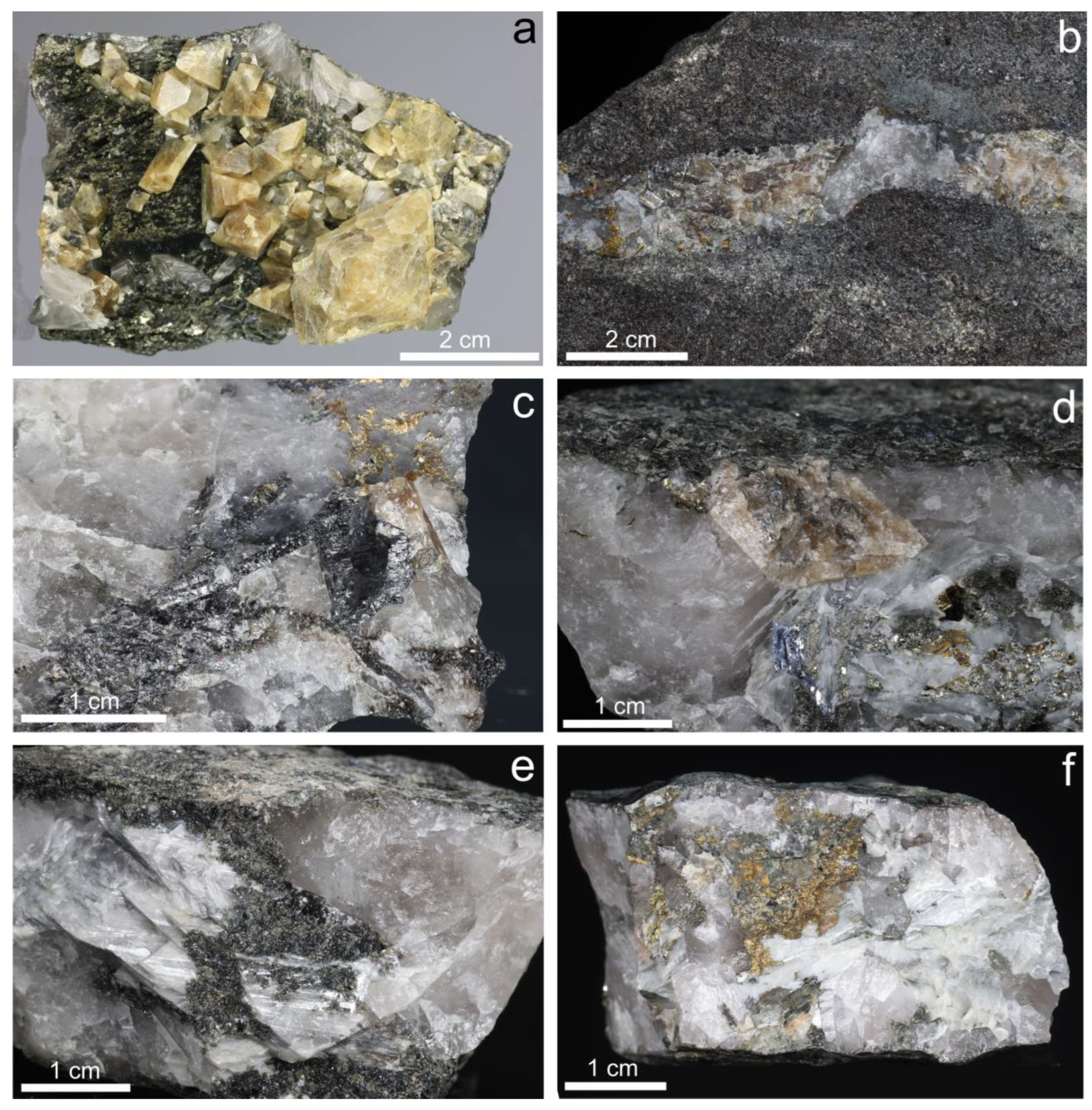
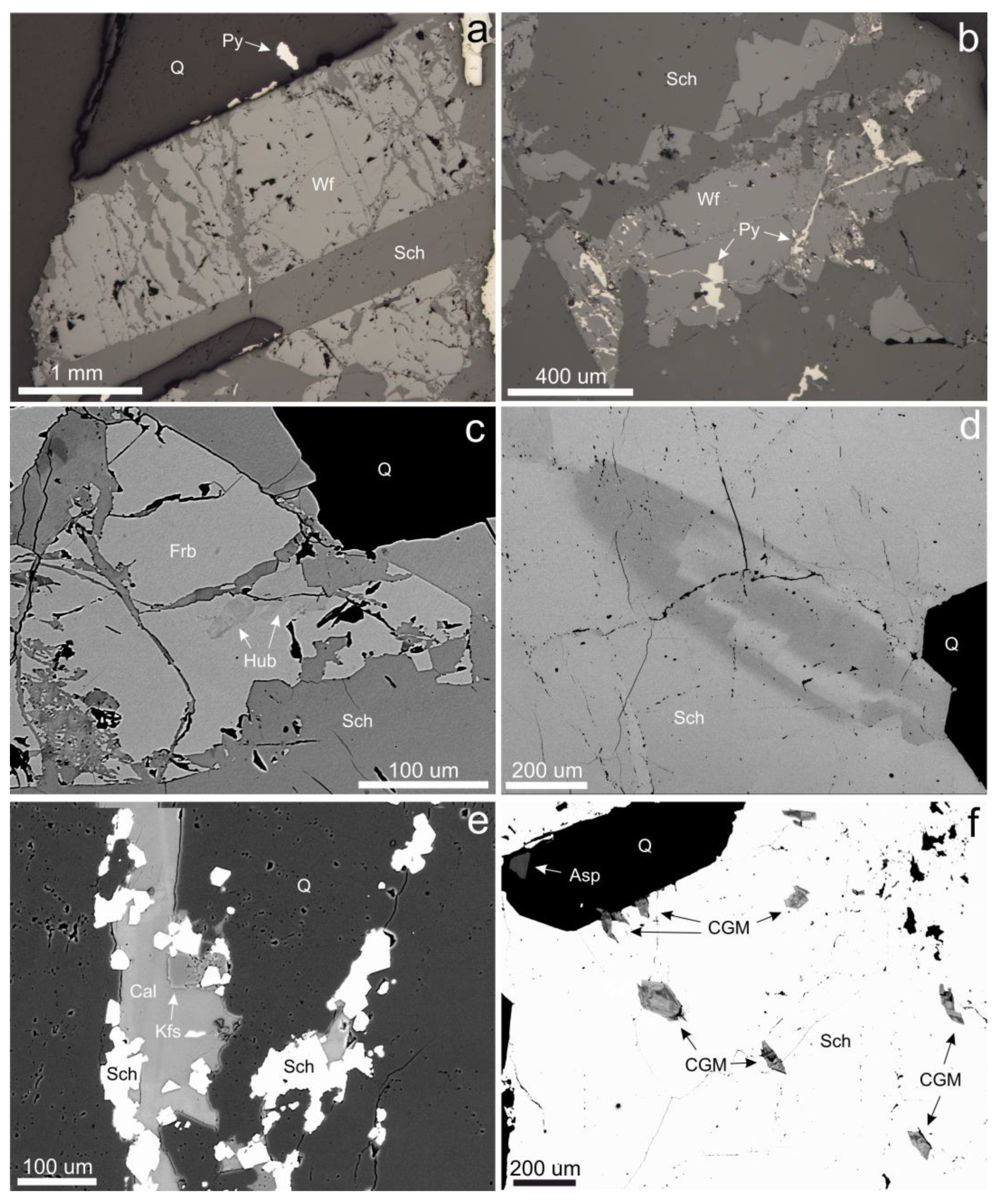
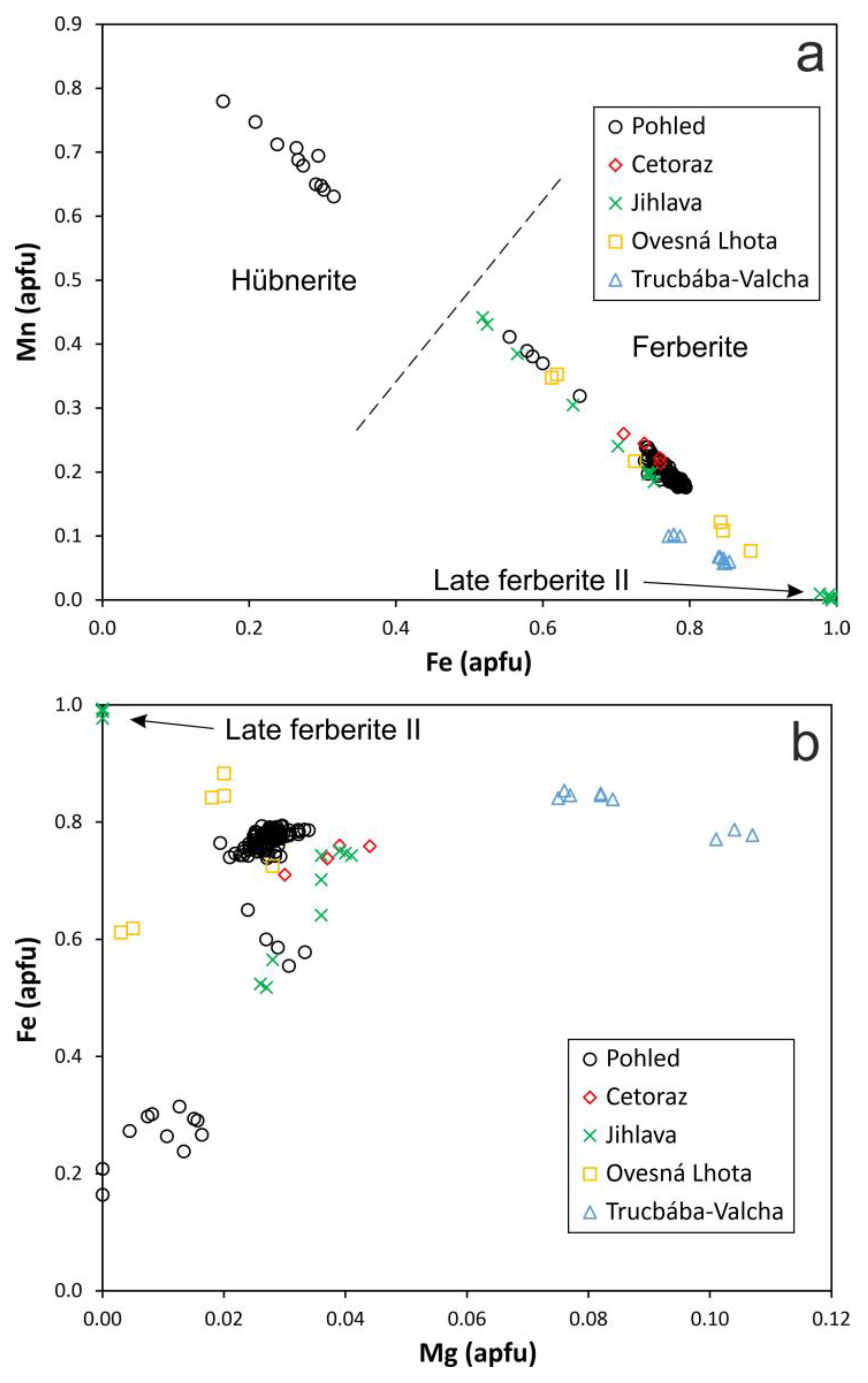
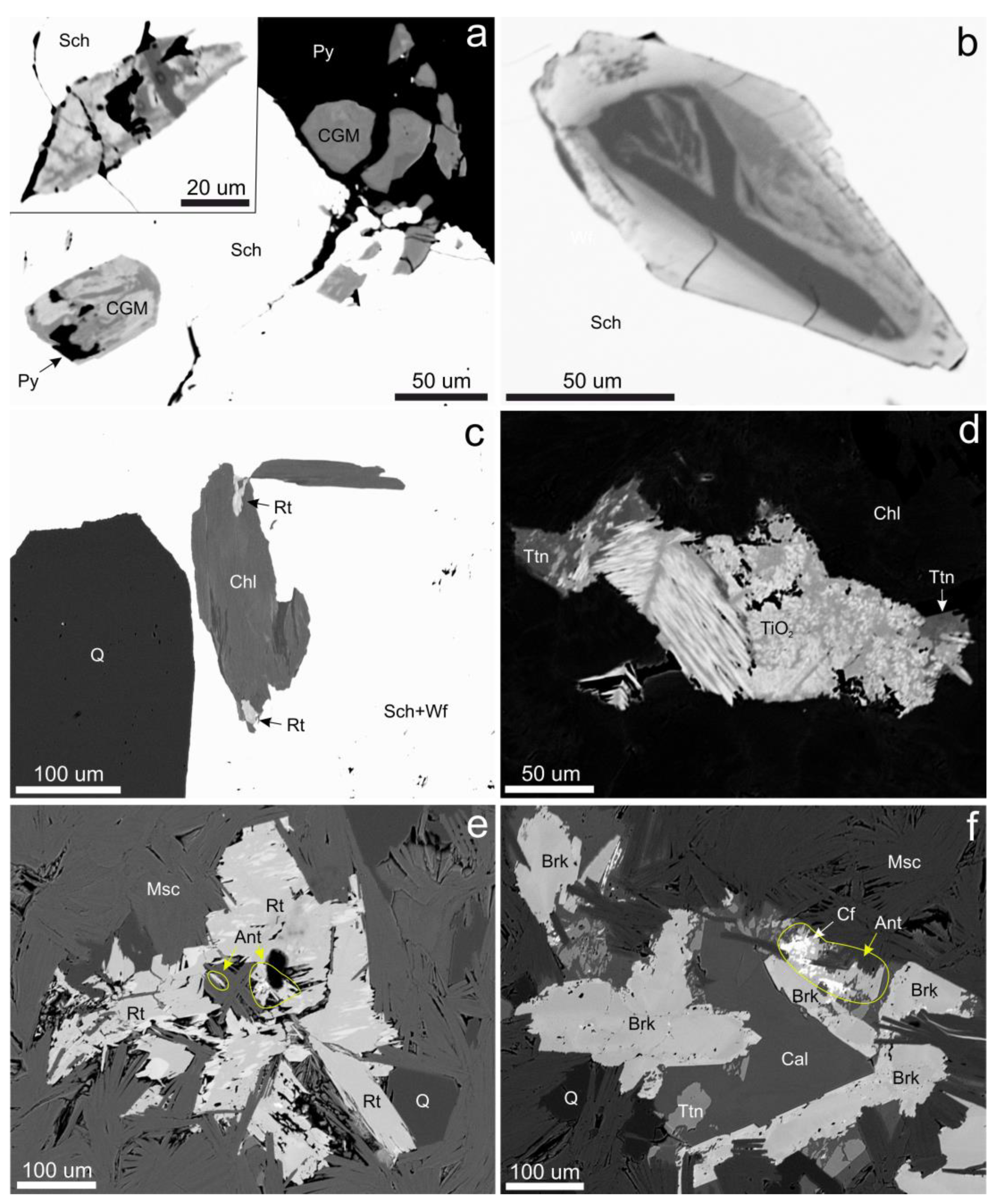
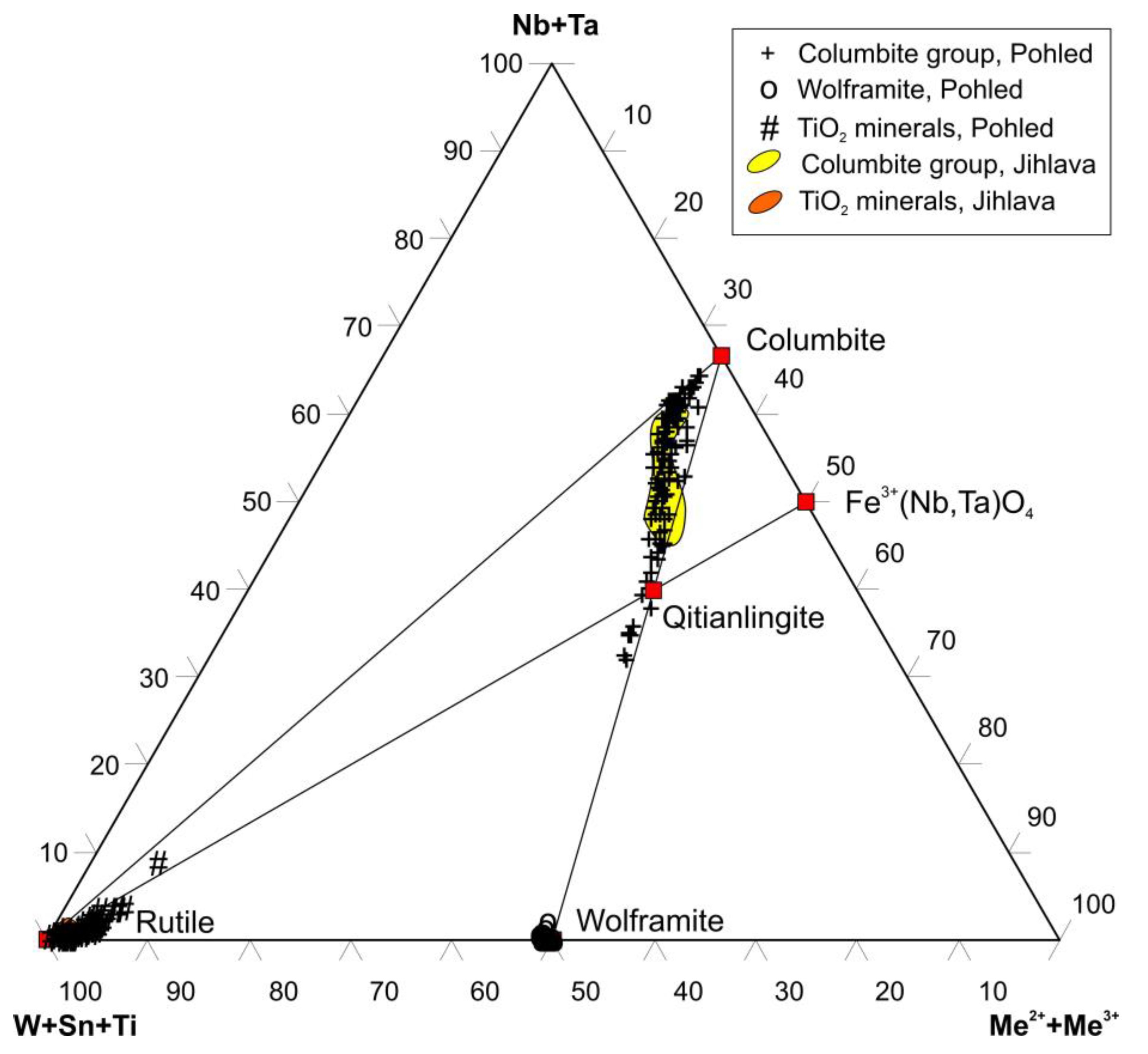

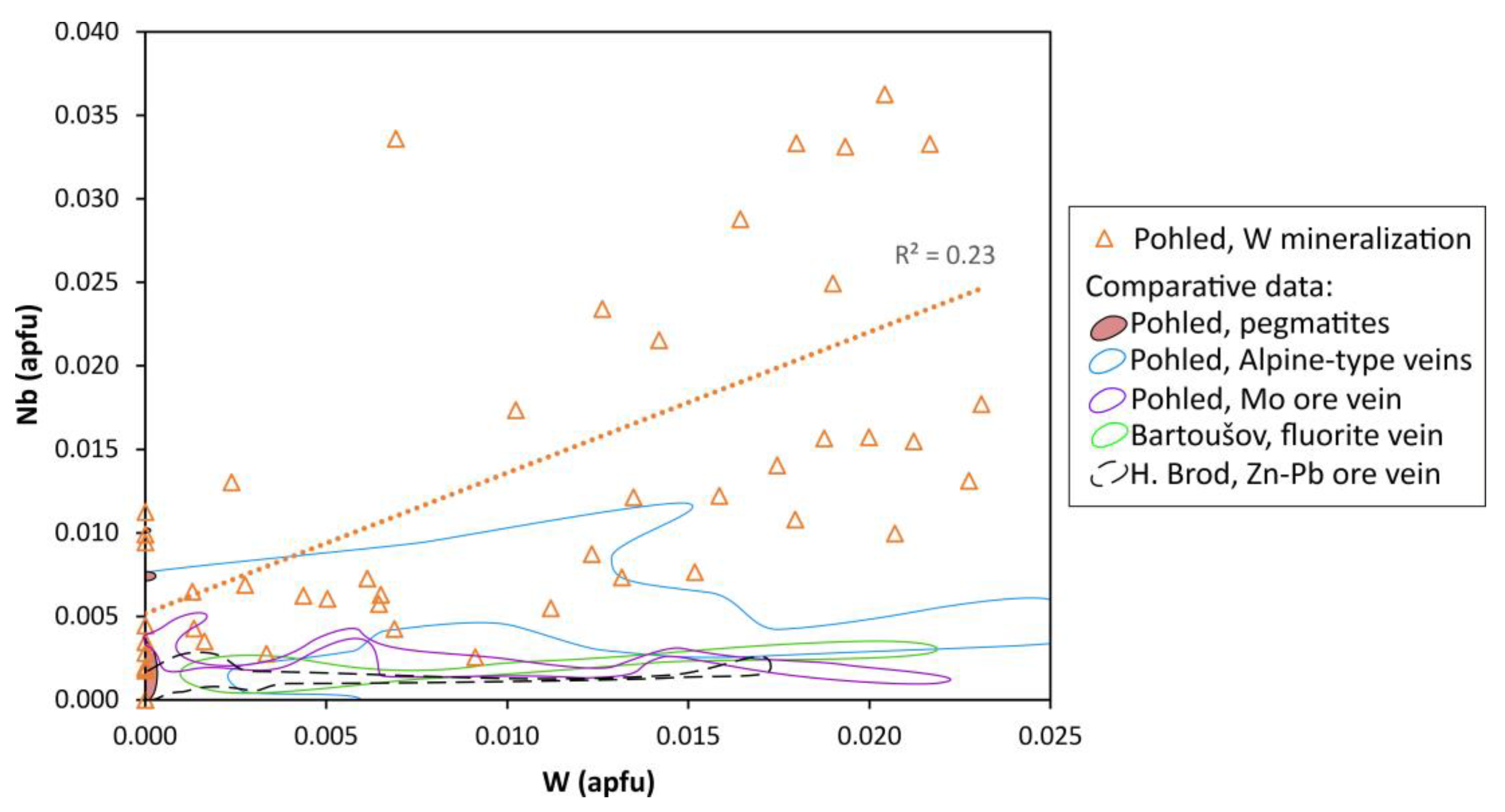
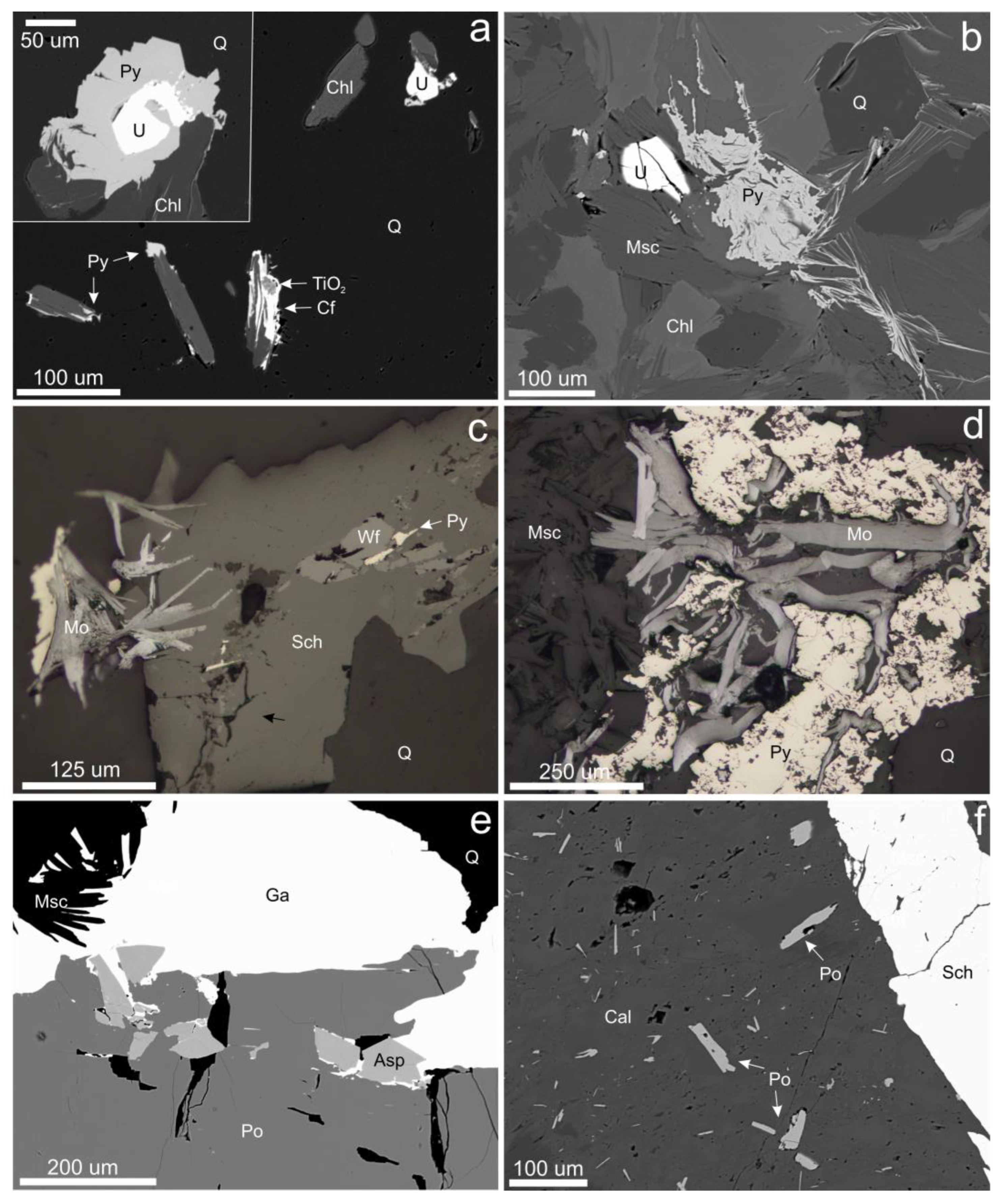

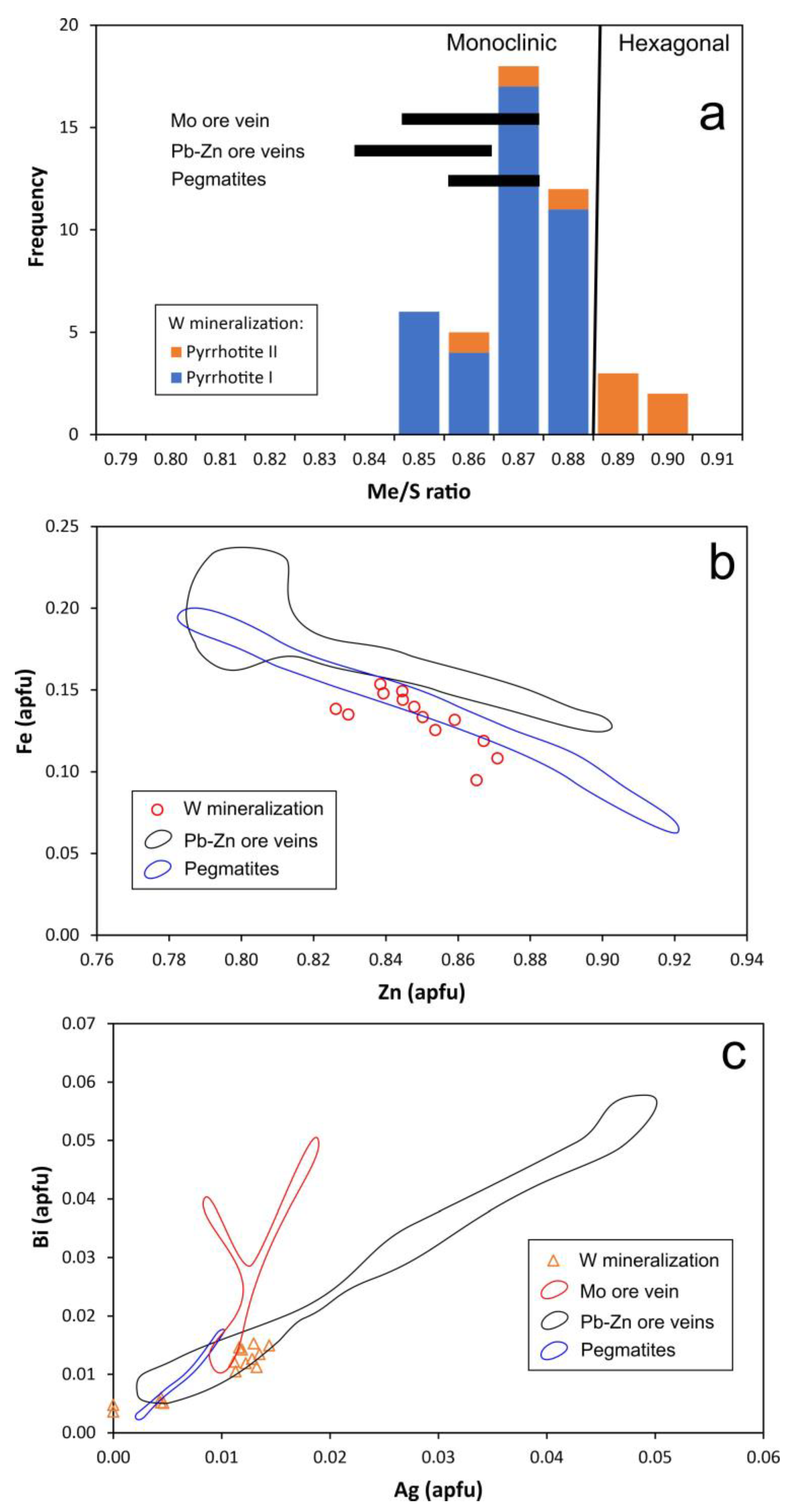
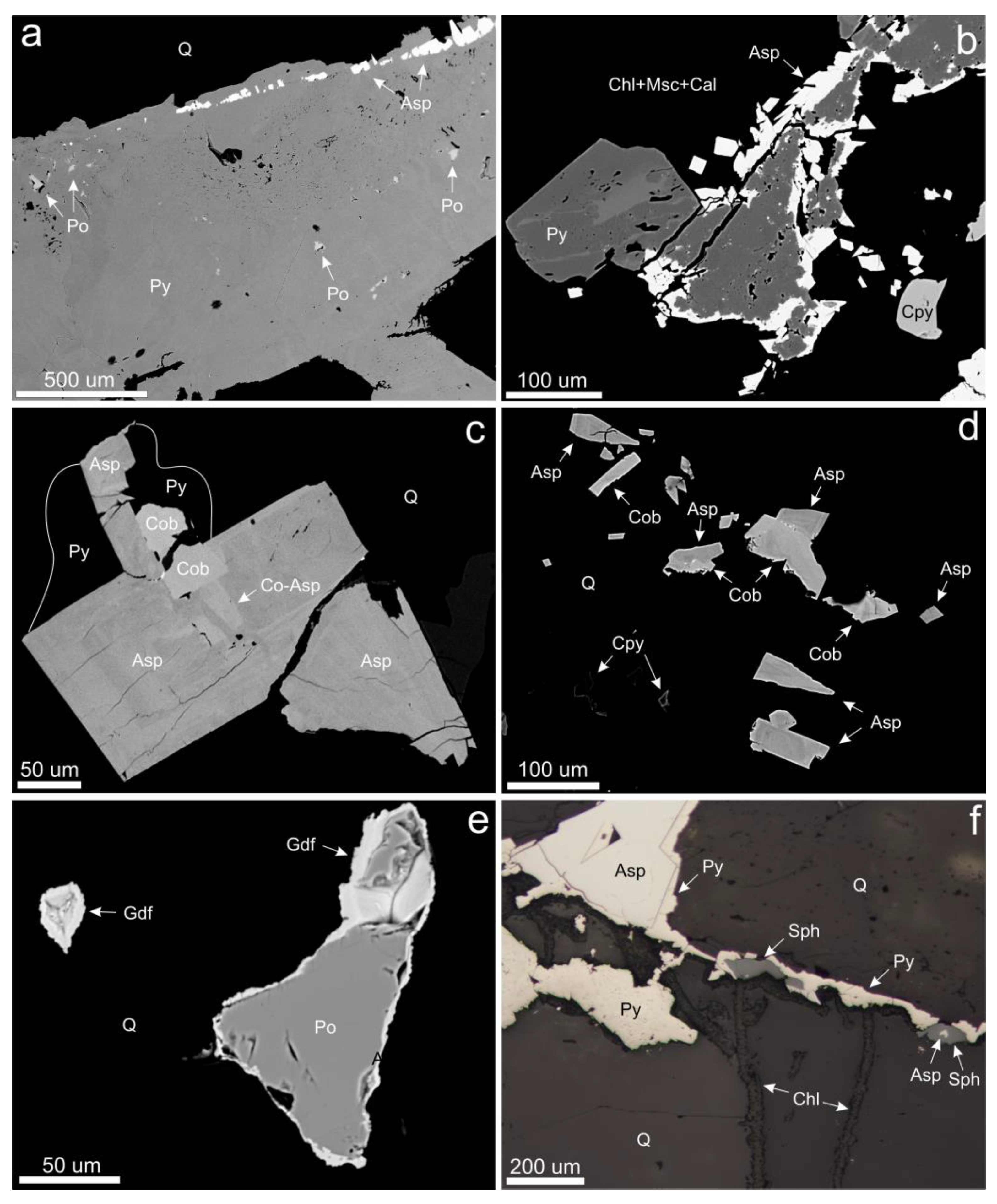


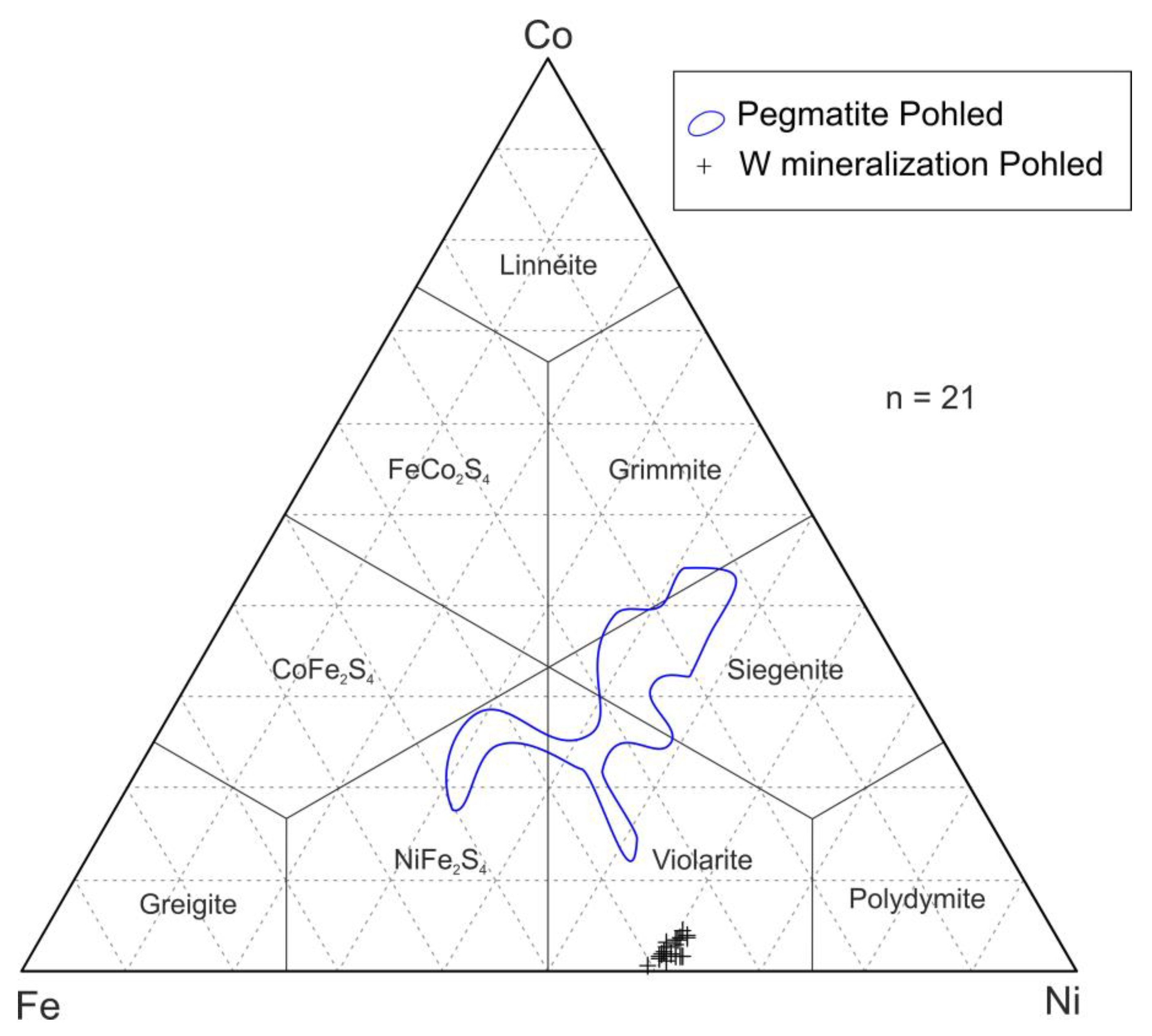
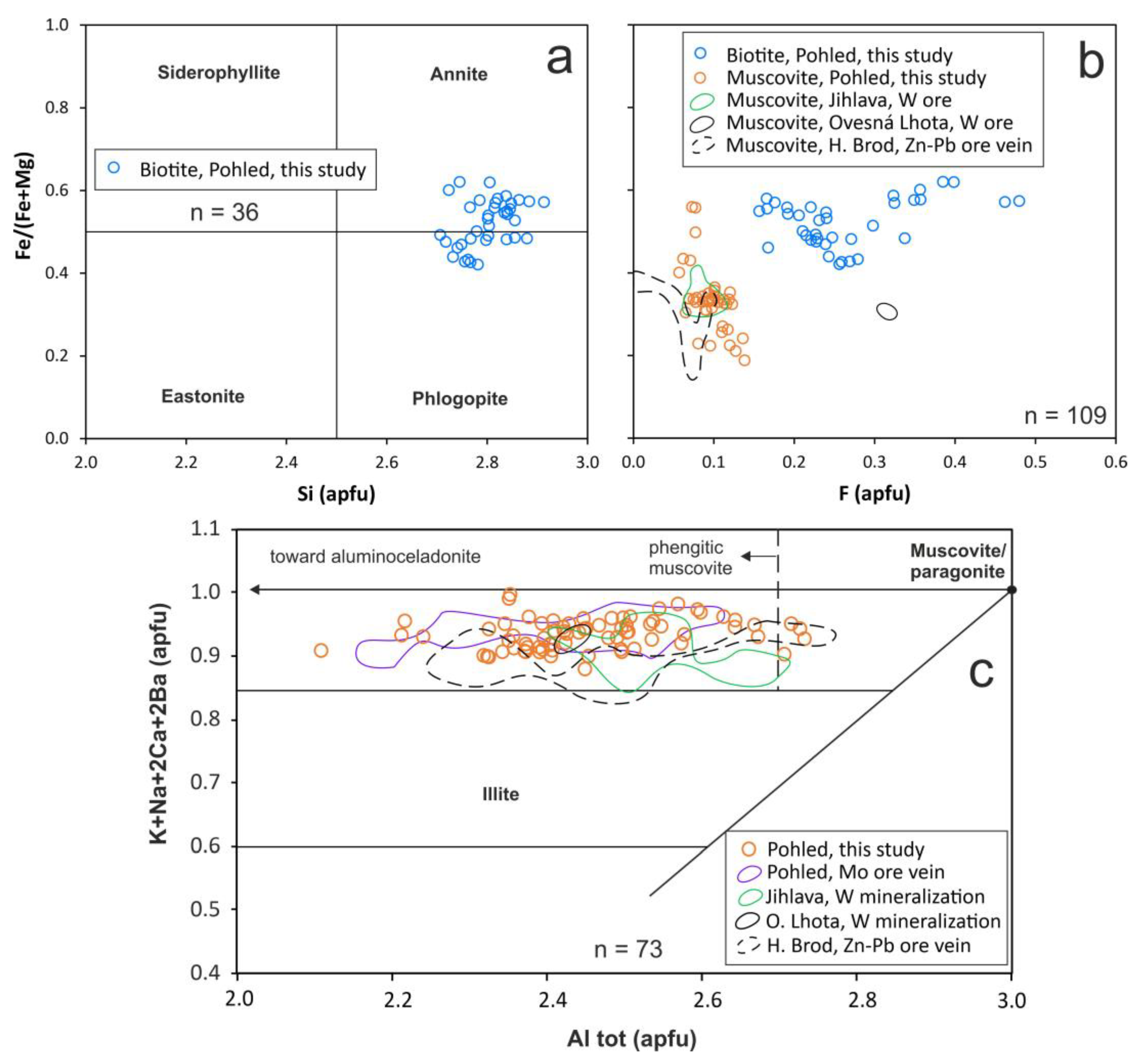

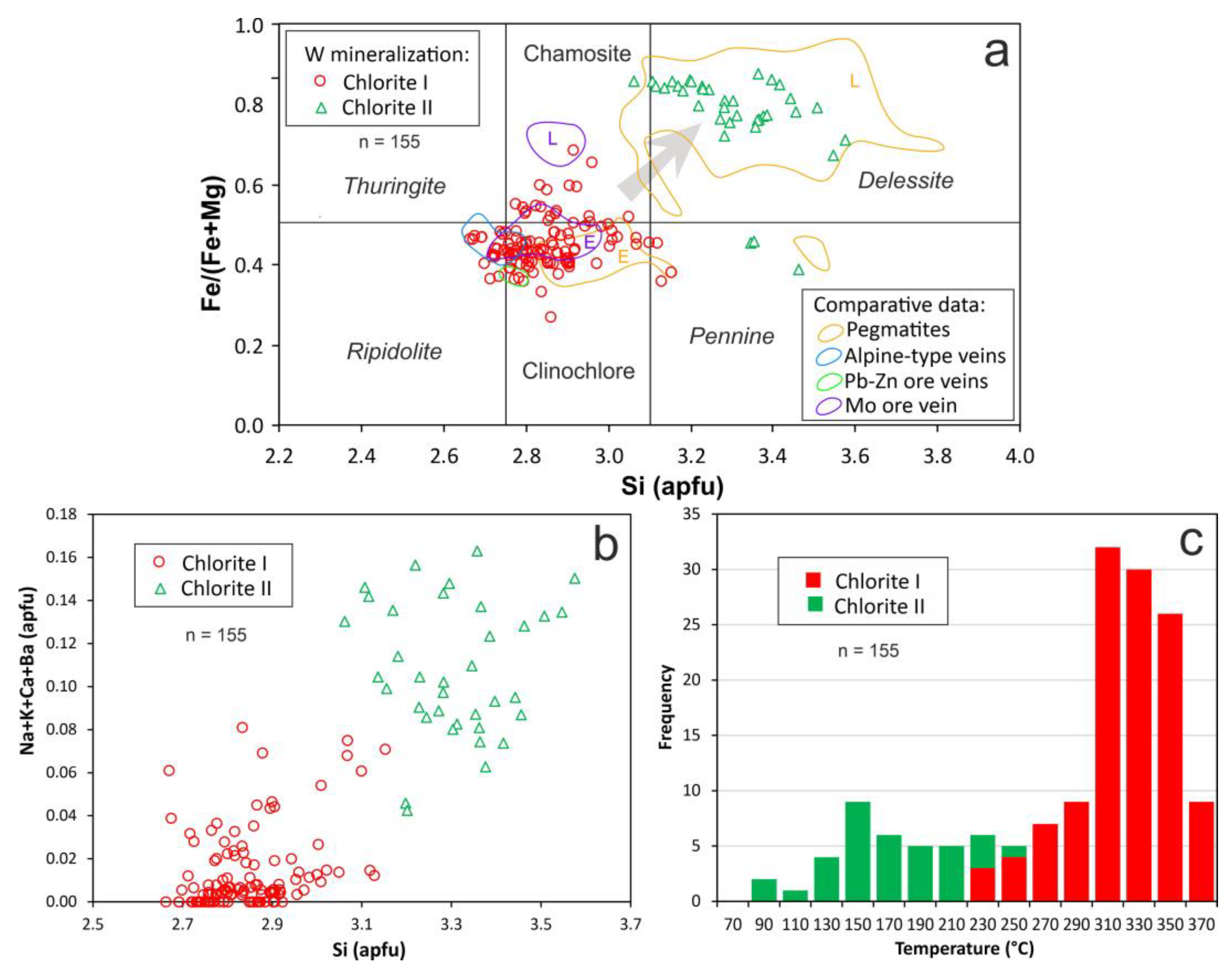
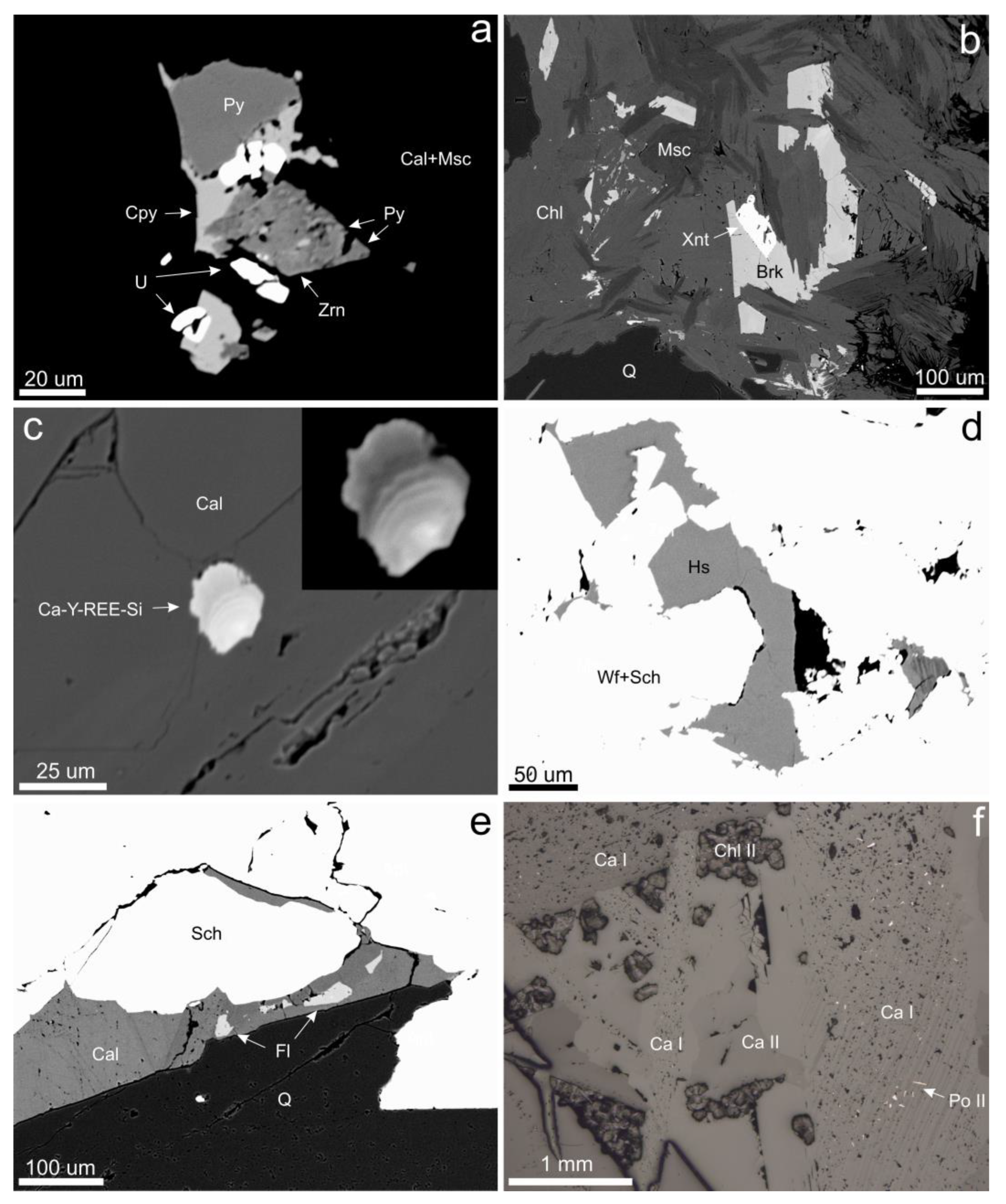
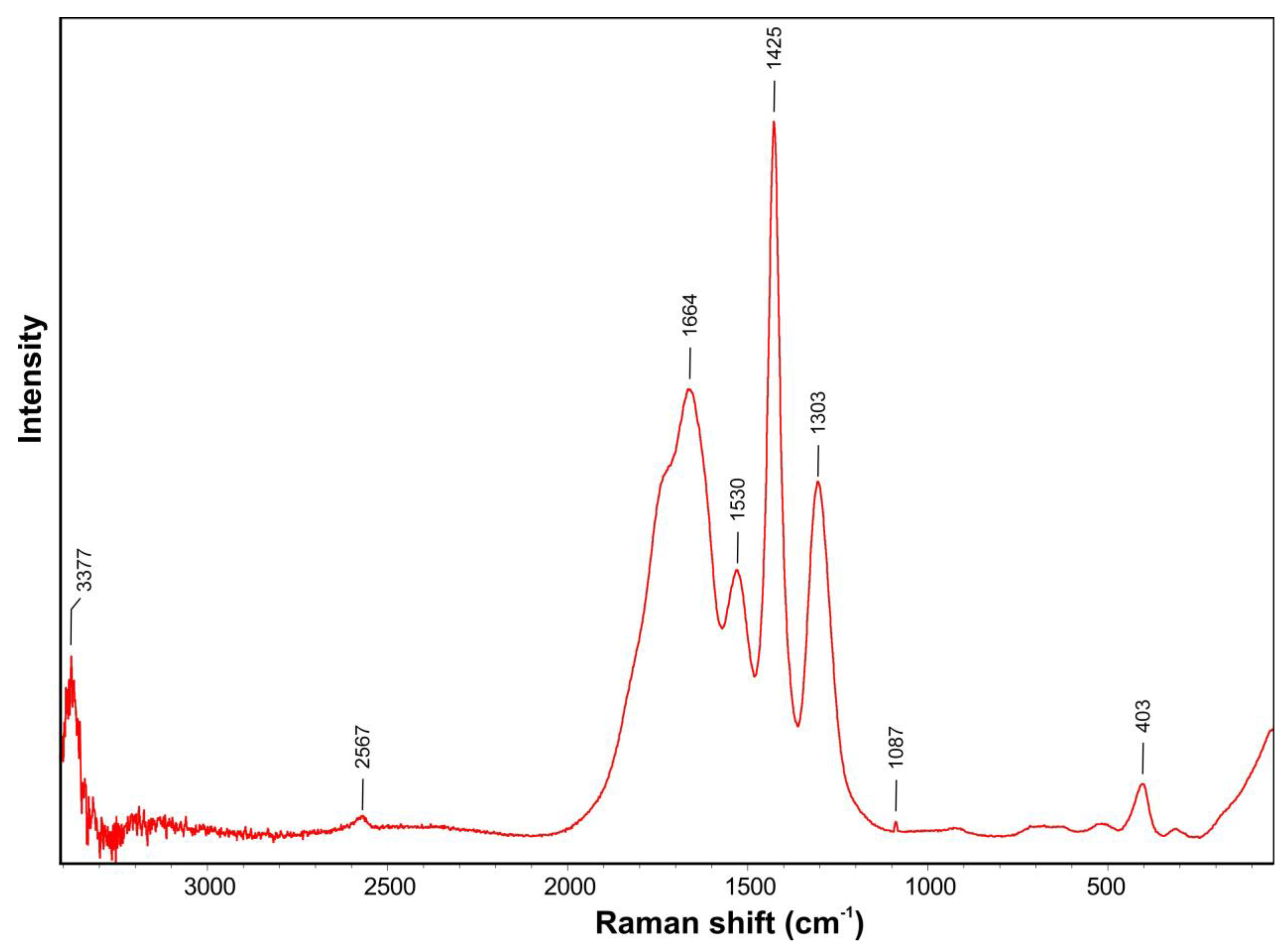


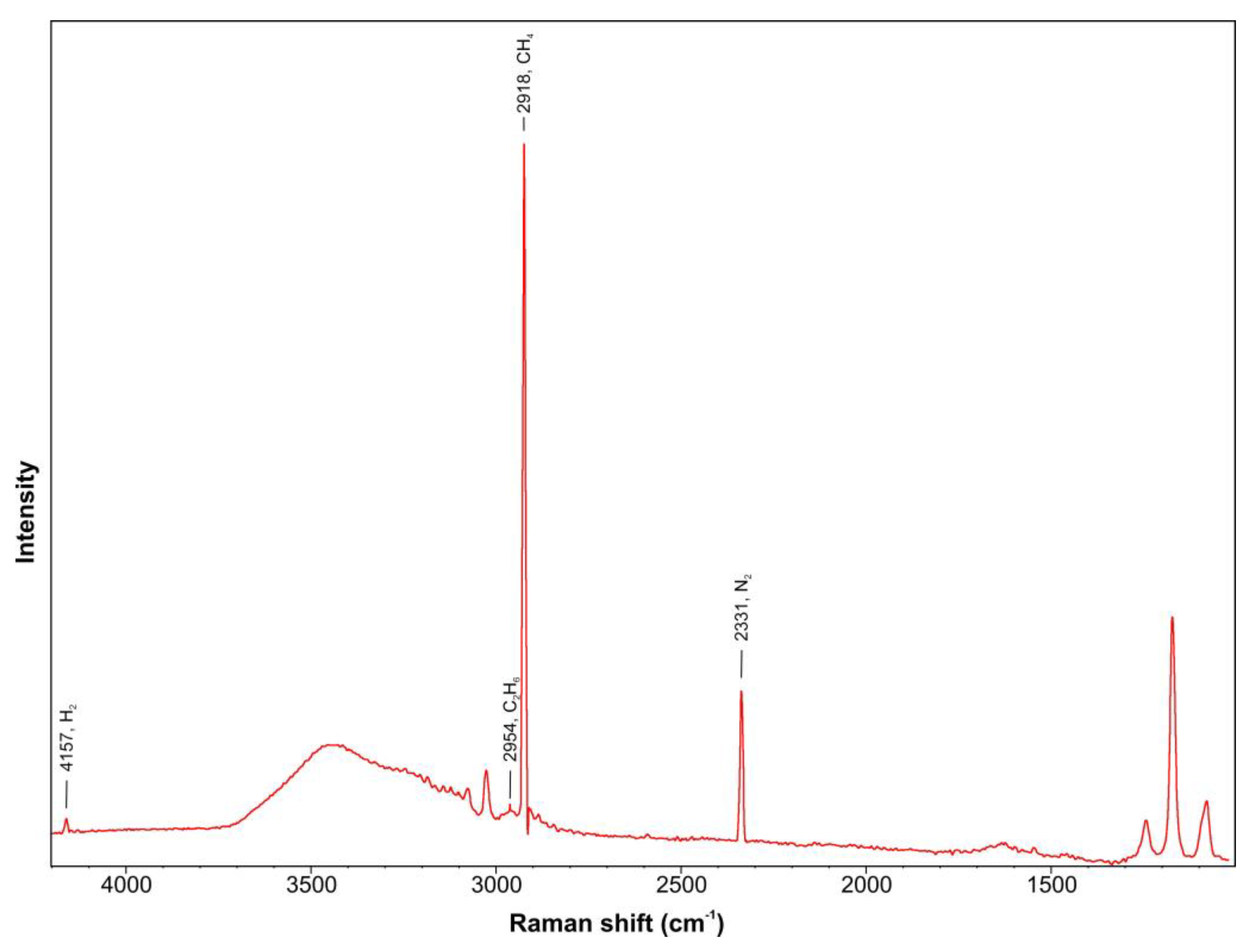
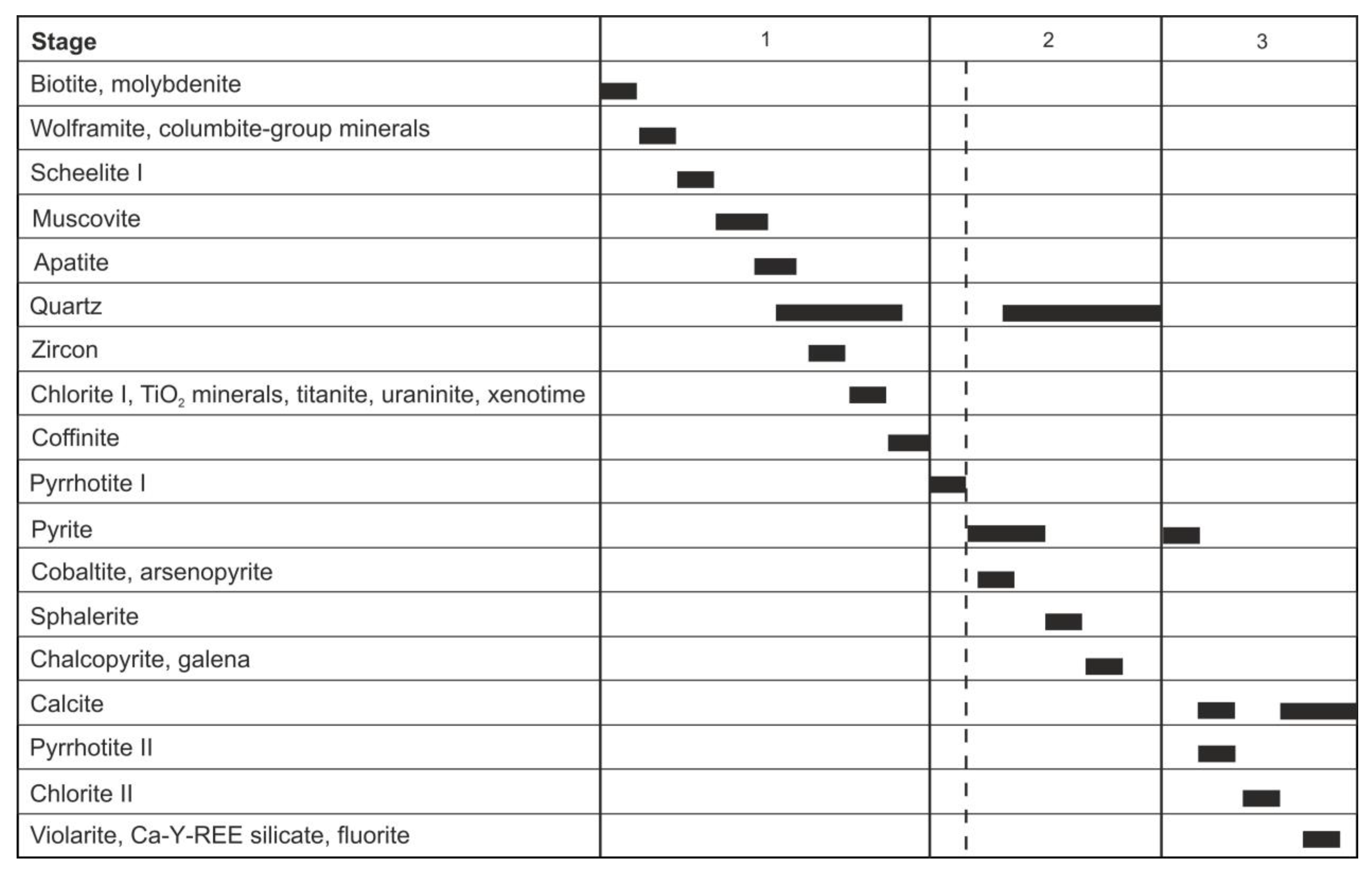
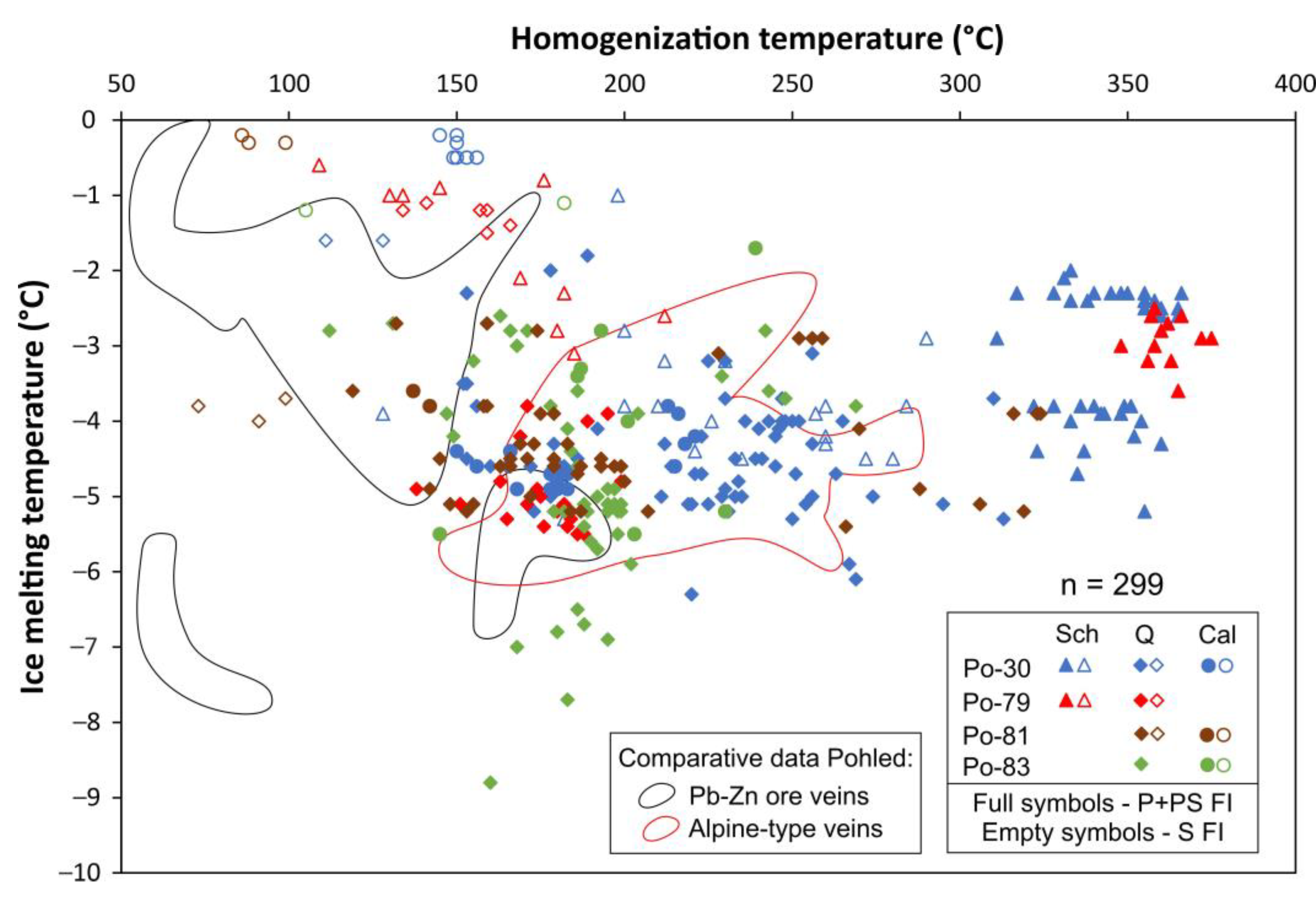
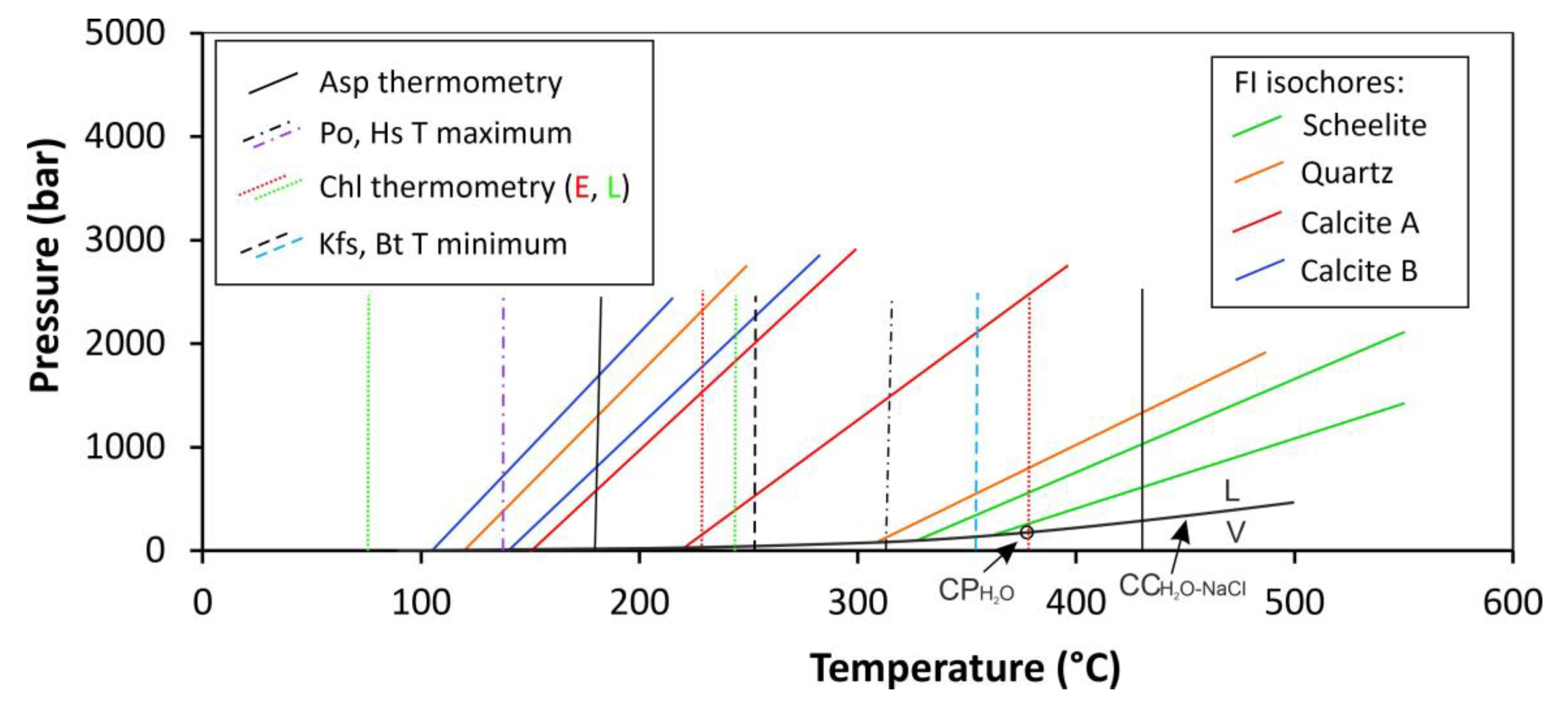
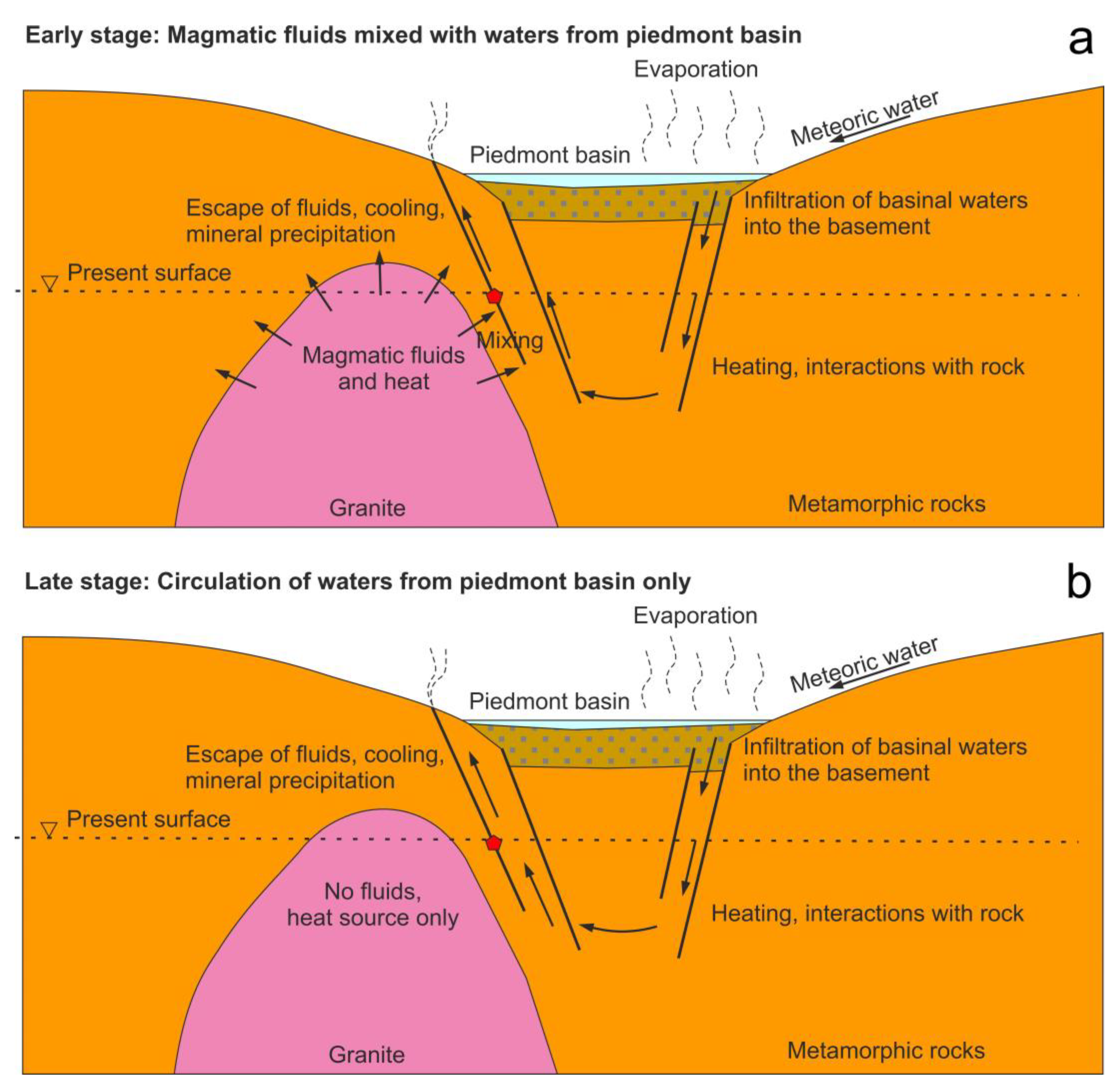
| Sample | Mineral | Gen. | Phase Comp. | Th (L) | Tf | Te | Tmice | Salinity |
|---|---|---|---|---|---|---|---|---|
| Po-30 | Scheelite | P, PS | L + V | 311–366 (47) | −42/−40 | −37/−35 | −2.0/−5.2 (31) | 3.4–8.1 |
| Po-30 | Scheelite | S | L + V | 114–290 (30) | −50/−42 | −38/−35 | −1.0/−5.3 (19) | 1.7–8.3 |
| Po-30 | Quartz | P, PS | L + V | 160–313 (64) | −49/−37 | −38/−35 | −2.0/−6.3 (70) | 3.4–9.6 |
| Po-30 | Quartz | S | L + V, L | 72–128 (4) | −42/−37 | −37 | −1.6 (2) | 2.7 |
| Po-30 | Calcite | P, PS | L + V | 150–221 (29) | −50/−43 | −39/−35 | −3.8/−4.9 (21) | 6.2–7.7 |
| Po-30 | Calcite | S | L + V | 140–156 (12) | −41/−38 | n.d. | −0.2/−0.5 (9) | 0.4–0.9 |
| Po-79 | Scheelite | P, PS | L + V | 348–375 (24) | −52/−34 | −37/−34 | −2.6/−3.6 (19) | 4.3–5.9 |
| Po-79 | Scheelite | S | L + V | 109–212 (16) | −45/−38 | −35/−34 | −0.6/−3.1 (12) | 1.1–5.1 |
| Po-79 | Quartz | P, PS | L + V | 138–200 (27) | −50/−47 | −39/−36 | −3.9/−5.5 (23) | 6.3–8.5 |
| Po-79 | Quartz | S | L + V, L | 129–159 (10) | −42/−32 | −35 | −1.1/−2.4 (7) | 1.9–4.0 |
| Po-81 | Quartz | P, PS | L + V | 119–324 (52) | −51/−48 | −38/−35 | −2.7/−5.4 (49) | 4.5–8.4 |
| Po-81 | Quartz | S | L + V, L | 77–151 (11) | −50/−35 | −36 | −3.7/−5.4 (5) | 6.0–8.4 |
| Po-81 | Calcite | P, PS | L + V, L | 105–142 (23) | −48/−41 | −35 | −0.3/−3.8 (6) | 0.5–6.2 |
| Po-81 | Calcite | S | L, L + V | 86–115 (9) | −42/−40 | n.d. | −0.2/−0.3 (3) | 0.4–0.5 |
| Po-83 | Quartz | P, PS | L + V | 122–249 (48) | −55/−48 | −41/−34 | −2.6/−8.8 (51) | 4.3–12.6 |
| Po-83 | Calcite | P, PS | L + V | 186–245 (11) | −50/−39 | −35 | −1.7/−5.5 (11) | 2.9–8.5 |
| Po-83 | Calcite | S | L + V | 126–182 (9) | −42/−40 | n.d. | −0.1/−1.2 (5) | 0.2–2.1 |
Disclaimer/Publisher’s Note: The statements, opinions and data contained in all publications are solely those of the individual author(s) and contributor(s) and not of MDPI and/or the editor(s). MDPI and/or the editor(s) disclaim responsibility for any injury to people or property resulting from any ideas, methods, instructions or products referred to in the content. |
© 2024 by the authors. Licensee MDPI, Basel, Switzerland. This article is an open access article distributed under the terms and conditions of the Creative Commons Attribution (CC BY) license (https://creativecommons.org/licenses/by/4.0/).
Share and Cite
Dolníček, Z.; Ulmanová, J.; Vrtiška, L.; Malý, K.; Krejčí Kotlánová, M.; Koutňák, R. Mineralogy and Origin of Vein Wolframite Mineralization from the Pohled Quarry, Havlíčkův Brod Ore District, Czech Republic: Interaction of Magmatic and Basinal Fluids. Minerals 2024, 14, 610. https://doi.org/10.3390/min14060610
Dolníček Z, Ulmanová J, Vrtiška L, Malý K, Krejčí Kotlánová M, Koutňák R. Mineralogy and Origin of Vein Wolframite Mineralization from the Pohled Quarry, Havlíčkův Brod Ore District, Czech Republic: Interaction of Magmatic and Basinal Fluids. Minerals. 2024; 14(6):610. https://doi.org/10.3390/min14060610
Chicago/Turabian StyleDolníček, Zdeněk, Jana Ulmanová, Luboš Vrtiška, Karel Malý, Michaela Krejčí Kotlánová, and Rostislav Koutňák. 2024. "Mineralogy and Origin of Vein Wolframite Mineralization from the Pohled Quarry, Havlíčkův Brod Ore District, Czech Republic: Interaction of Magmatic and Basinal Fluids" Minerals 14, no. 6: 610. https://doi.org/10.3390/min14060610
APA StyleDolníček, Z., Ulmanová, J., Vrtiška, L., Malý, K., Krejčí Kotlánová, M., & Koutňák, R. (2024). Mineralogy and Origin of Vein Wolframite Mineralization from the Pohled Quarry, Havlíčkův Brod Ore District, Czech Republic: Interaction of Magmatic and Basinal Fluids. Minerals, 14(6), 610. https://doi.org/10.3390/min14060610








